The Banshees of Inisherin
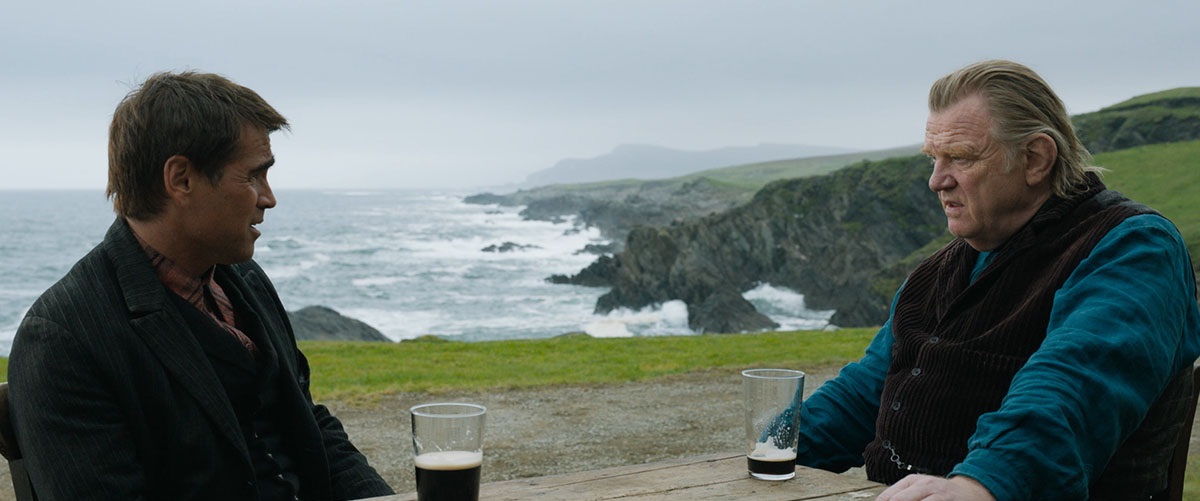
One thing I didn't have on my lifetime cinematic bingo card—and I bet it is not on yours either—was Colin Farrell and Brendan Gleeson become the 21 st century's answer to Laurel and Hardy. And yet. With 2008's " In Bruges ," and now "The Banshees of Inisherin," the Irish actors, under the writing and directing aegis of frequently pleasantly perverse Martin McDonagh , display a chemistry and virtuosic interplay that recalls nothing so much as the maestros of the early 20 th -century Comedy of Exasperation.
This being a McDonagh work, it's a comedy of mortification as well as exasperation. It begins with a beautiful overhead shot of the title Irish island, all green below a clear blue sky (in this picture it only rains at night, which, considering actual weather patterns in Ireland, places the film in yet another genre, that of fantasy). The Carter Burwell score evokes idyllic times, and we see life is rather easy for Pádraic (Farrell) a milk farmer who lives with his sister in a modest cottage and, apparently, calls on his old friend Colm (Gleeson) just about every day at two. Before he sets out, he makes a remark about Colm to his sister Siobhán ( Kerry Condon ), who sarcastically replies, "Maybe he just don't like you no more."
This turns out to be a bit of inadvertent prophecy. Because Colm rebuffs Pádraic. Over the course of several discussions, we learn that Colm has come to find Pádraic dull (and the earnest fellow's conversation is indeed limited, if amiable), and that he believes he's got better things to do with his time, like compose songs on his fiddle. When Colm goes to confession at the island's church, he reveals he's also suffering from despair. He's suffering from quite a bit more than that.
"Banshees" is set in 1923, and several times its characters discuss hearing guns going off on the not-too-far-away mainland. The conflict between Colm and Pádraic serves as a handy metaphor for Ireland's Civil War at that time, but the movie works best when it doesn't foreground that metaphor. Which becomes rather grisly, as a commentary on a particularly Irish kind of obstreperousness. As in: Colm tells Pádraic that if the latter continues to talk to Colm, or at Colm, after Colm's made it clear that the doesn't want Pádraic's company or conversation, Colm will cut off one of his fingers. Now keep in mind that Colm's a fiddler who wants to continue fiddling, so this is actually, as a strategy, a sight worse than cutting off one's nose to spite his face.
And so, after Pádraic gets in Colm's face again, Colm actually does it. One of the neatest tricks of the movie is how McDonagh leads the viewer to identify more with Colm than with Pádraic early on. One feels: yeah, this is a rude severing of friendship on Colm's part, but why can't Pádraic just let the guy be? Some of Colm's points are well taken. Colm's probably better for Pádraic than Dominic, the exceedingly rude policeman's son who makes Pádraic look like an urbane conversationalist, but sometimes these are the breaks, social-life wise. But once the fingers begin coming off, your jaw slackens and your eyes pop. Where's this going to end?
Nobody does self-loathing like the Irish, and with this film, McDonagh is on much surer footing than he was when trying to tell America a thing or two with his film " Three Billboards Outside Ebbing, Missouri " in 2017. "Banshees" has got touches of tenderness that are sometimes ever-so-slightly confounding, as when Colm shows care for Pádraic after the latter gets a pasting from Dominic's bastard cop father. Being the writer he is, he often counters those with bracing reality checks. And as a director, he orchestrates the give-and-take between Farrell and Gleeson with the mastery of someone who appreciates these performers as much as discerning audiences do. They let it fly; Farrell does some of his best acting with his furrowed eyebrows; Gleeson has a glare that's both a death-ray and an enigma. The pauses these guys enact are at times even funnier than the verbal comebacks McDonagh has come up with for them. And as it happens, Barry Keoghan as Dominic almost steals the movie out from under the leads, his very funny vulgar brashness never quite camouflaging his character's poignant vulnerability. Very good show all around.
This review was filed from the world premiere at the Venice Film Festival on September 5th. It opens only in theaters on October 21st.
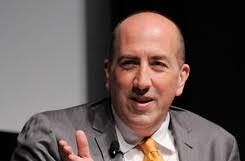

Glenn Kenny
Glenn Kenny was the chief film critic of Premiere magazine for almost half of its existence. He has written for a host of other publications and resides in Brooklyn. Read his answers to our Movie Love Questionnaire here .
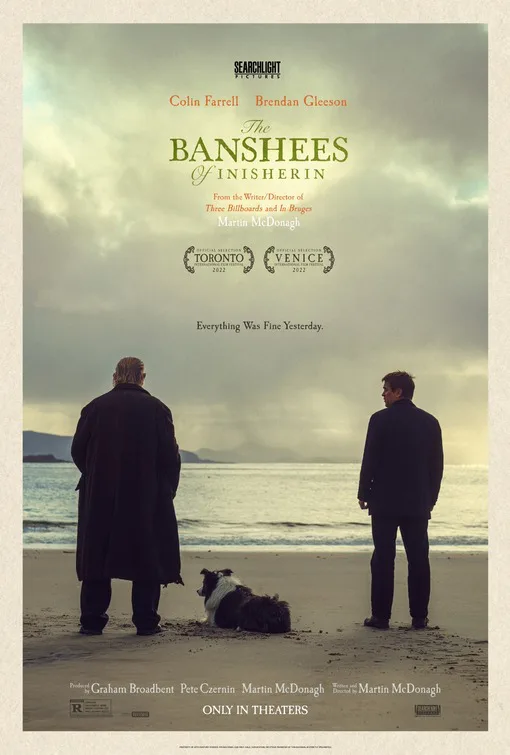
- Colin Farrell as Pádraic
- Brendan Gleeson as Colm
- Kerry Condon as Siobhán
- Barry Keoghan as Dominic
Cinematographer
- Carter Burwell
- Martin McDonagh
- Mikkel E.G. Nielsen
Leave a comment
Now playing.

The Piano Lesson
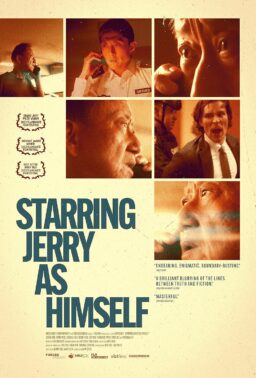
Starring Jerry As Himself
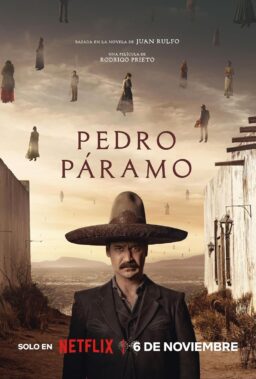
Pedro Páramo
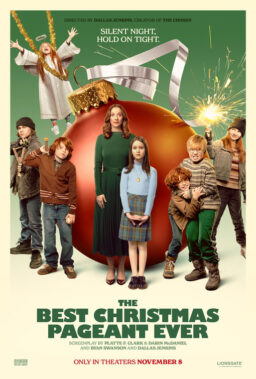
The Best Christmas Pageant Ever

A Real Pain
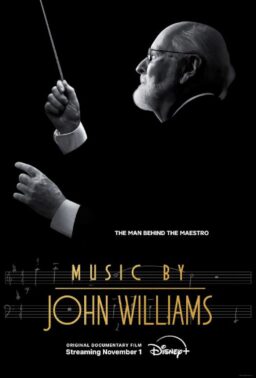
Music by John Williams
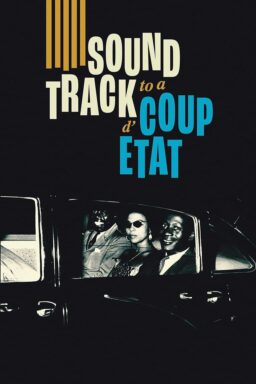
Soundtrack to a Coup d'État

No Other Land
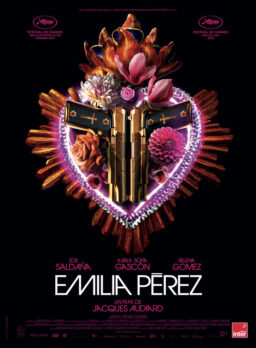
Emilia Pérez
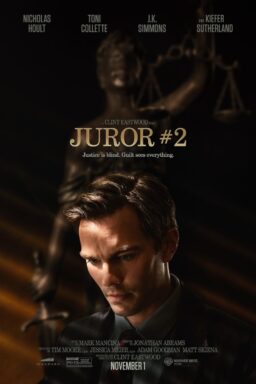
Latest articles
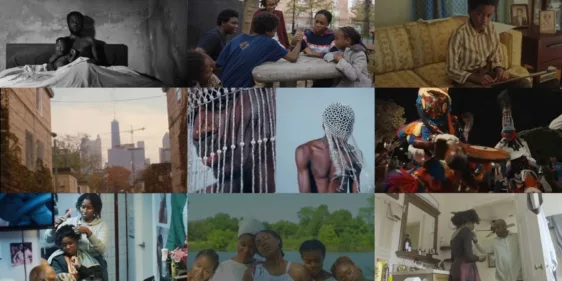
Black Harvest Film Festival 2024 Preview
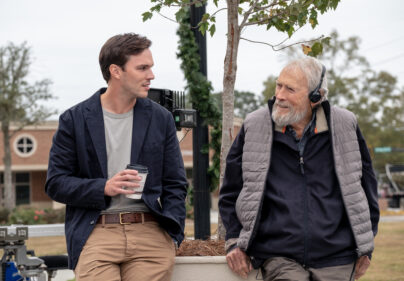
A Prophet is Without Honor in His Own Country; or, The Curious Case of Clint Eastwood
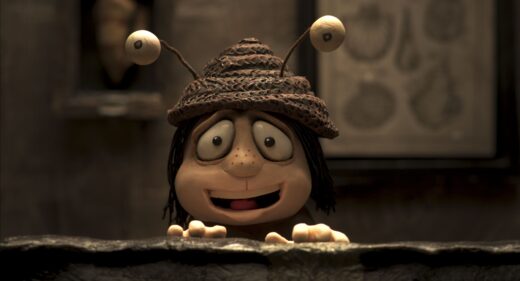
Living Forward: Adam Elliot on "Memoir of a Snail"
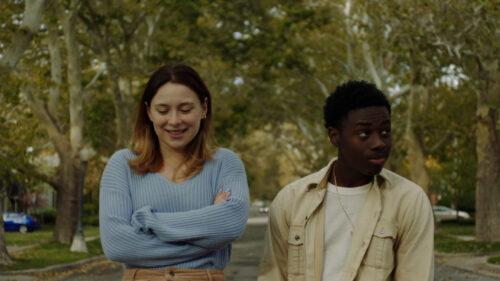
Female Filmmakers in Focus: Hannah Peterson on "The Graduates"
The best movie reviews, in your inbox.
Advertisement
Supported by
‘The Banshees of Inisherin’ Review: Giving Your Friend the Finger
Colin Farrell and Brendan Gleeson play feuding frenemies in Martin McDonagh’s latest film, set on an Irish coast in 1923.
- Share full article

By A.O. Scott
The island of Inisherin, a rustic windswept rock off the coast of Ireland, does not appear on any real-world maps, but its geography is unmistakable. Not only because the sweaters and the sheep, the pints of Guinness and the thatched roofs bespeak a carefully curated Irish authenticity, but also because what happens on this island locates it firmly in an imaginary region that might be called County McDonagh.
This is a place, governed by the playful and perverse sensibility of the dramatist and filmmaker Martin McDonagh, where the picturesque and the profane intermingle, where jaunty humor keeps company with gruesome violence. The boundaries of the realm extend from Spokane, Wash ., to the Belgian city of Bruges by way of Missouri and various actual and notional Irish spots. “The Banshees of Inisherin,” McDonagh’s new film, embellishes the cartography without necessarily breaking new ground. It’s a good place to start if you’re new to his work, and cozily — which is also to say horrifically — familiar if you’re already a fan.
Other McDonagh hallmarks include a breakneck, swaybacked plot, by turns hilarious and grim, painted over with a nearly invisible varnish of sentimentality. It’s not necessary to believe what you see — it may, indeed, not be possible — but you can nonetheless find yourself beguiled by the wayward sincerity of the characters and touched by the sparks of humanity their struggles cast off. And impressed by the craft of the actors and the crew (which here includes the cinematographer Ben Davis, the composer Carter Burwell and the costume designer Eimer Ni Mhaoldomhnaigh). Perhaps above all, you are apt to be tickled, sometimes to gales of laughter, by the spray of verbal wit that characterizes the McDonagh dialect.
It’s 1923, though modernity has dawdled a bit en route to Inisherin, where rural life proceeds at its immemorial pace. On the mainland, the Irish Civil War drags on; distant gunfire can sometimes be heard across the water. The islanders pay it very little mind, and don’t see any point to taking a side. The local constable (Gary Lydon), a dull, violent brute and the closest thing to a pure villain this movie possesses, is pleased to have been recruited to assist in an execution. He doesn’t know or care whether the National Army or the I.R.A. is responsible for the killing. He’s content to gawk and get paid.
“Banshees,” in any case, is concerned with an intensely local conflict, between Padraic (Colin Farrell), a sociable cow herder, and Colm (Brendan Gleeson), a melancholy fiddler. They have been drinking together nearly every afternoon at the local shebeen for as long as anyone can remember, until Colm abruptly and unilaterally declares an end to their friendship. “I just don’t like you no more,” he tells Padraic, who responds with wounded incredulity.
Colm is quite serious. Every time Padraic dares to talk to him, he vows, he will cut off one of his own fingers. This shocking, irrational threat — a violinist promising to sever himself from his art — gives the story a queasy momentum. Even after the digits start to fly — Colm flings them at the door of Padraic’s cottage — it’s hard for Padraic or the audience to accept what’s happening, let alone understand it.
What is Colm’s problem? He may be a bit more worldly than his neighbors. The masks and other objects that decorate his house suggest an acquaintance with — or maybe just a curiosity about — the world beyond the island. Gleeson plays him as a storm cloud in a billowing overcoat, an artist whose temperament is at once too delicate and too volatile for his surroundings. The parish priest worries that he’s prone to the sin of despair, which sounds simplistic but not entirely inaccurate.

You can understand how Colm might be annoyed with Padraic — part of Farrell’s charm is that he’s always at least a little bit annoying — and that Colm is desperate for a change in his routine. He’s composing a new tune, and time spent with a trifling drinking buddy threatens to distract him from this potential masterpiece. Still, self-mutilation seems a bit extreme.
Not necessarily in McDonagh’s world. (See also: “A Behanding in Spokane.” ) Colm and Padraic are flanked by sundry other Inisherinites, human and otherwise. Colm lives with a patient Border collie. Padraic, surrounded by livestock of various kinds, is especially attached to a miniature donkey named Jenny. He also lives with his put-upon, sensible sister, Siobhan (Kerry Condon), who quietly dreams of leaving Inisherin, and sometimes passes the time with Dominic (Barry Keoghan), the intellectually challenged son of that dastardly constable.
Some of these creatures are marked out for tragedy — a witchy old widow prophesies general doom whenever she passes someone on the road or stops in for tea — and McDonagh doles out misery and humor with an expert hand.
“The Banshees of Inisherin” might feel a little thin if you hold it to conventional standards of comedy or drama. It’s better thought of as a piece of village gossip, given a bit of literary polish and a handsome pastoral finish. Inisherin may not be a real place, but its eccentric characters, rugged vistas and vivid local legends make it an attractive tourist destination all the same.
The Banshees of Inisherin Rated R. Salty language and bloody deeds. Running time: 1 hour 49 minutes. In theaters.
An earlier version of this article misspelled the name of the miniature donkey to which Colin Farrell’s character is attached in “The Banshees of Inisherin.” She is Jenny, not Jennie.
When we learn of a mistake, we acknowledge it with a correction. If you spot an error, please let us know at [email protected] . Learn more
A.O. Scott is a co-chief film critic. He joined The Times in 2000 and has written for the Book Review and The New York Times Magazine. He is also the author of “Better Living Through Criticism.” More about A.O. Scott
Explore More in TV and Movies
Not sure what to watch next we can help..
A Tearful Talk : Cynthia Erivo and Ariana Grande, the stars of the new movie “Wicked,” reflected on their long ride together , getting through Covid and the actors’ strike, and avoiding “playing to the green.”
Capturing America : As the wildly popular TV western “Yellowstone” prepares to air its final episodes, we look at four ways it seized the country’s attention .
Recreating War-Torn London : “Blitz,” Steve McQueen’s latest film, set in 1940 during Germany’s bombardment of the British capital, draws extensively from wartime photos .
Streaming Guides: If you are overwhelmed by the endless options, don’t despair — we put together the best offerings on Netflix , Max , Disney+ , Amazon Prime and Hulu to make choosing your next binge a little easier.
Watching Newsletter: Sign up to get recommendations on the best films and TV shows to stream and watch, delivered to your inbox.
- Cast & crew
- User reviews
The Banshees of Inisherin

Two lifelong friends find themselves at an impasse when one abruptly ends their relationship, with alarming consequences for both of them. Two lifelong friends find themselves at an impasse when one abruptly ends their relationship, with alarming consequences for both of them. Two lifelong friends find themselves at an impasse when one abruptly ends their relationship, with alarming consequences for both of them.
- Martin McDonagh
- Colin Farrell
- Brendan Gleeson
- Kerry Condon
- 1.1K User reviews
- 351 Critic reviews
- 87 Metascore
- 147 wins & 369 nominations total

Top cast 20

- Pádraic Súilleabháin

- Colm Doherty

- Siobhán Súilleabháin

- Jonjo Devine
- Peadar Kearney

- Dominic Kearney
- Mrs. McCormick
- Older Musician 1
- Older Musician 2
- Female Singer
- (as Lasairfhíona Ní Chonaola)

- Mrs. O'Riordan

- Student Musician 1
- Student Musician 2
- Student Musician 3
- All cast & crew
- Production, box office & more at IMDbPro
Colin Farrell Reunites With Brendan Gleeson
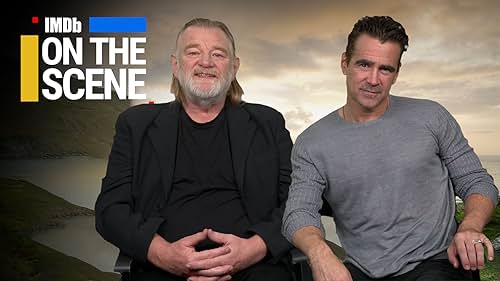
More like this

Did you know
- Trivia All of the main characters' sweaters were made by the same elderly woman, Delia Barry. She knitted them by hand specifically for the film, including doubles for each sweater. She was not present on set, and did not meet the actors prior to creating the pieces for them. Barry stated one of Colin Farrell's sweaters took 100 hours to complete.
- Goofs In the first scene in Colm's cottage, an old phonograph with a horn is seen, and heard playing a record. The record is spinning at 33 1/3 RPM, instead of 78 RPM, which was the ONLY speed used to play records in the early 1920's. The slower speed was not used until LP records were introduced in the late 1940s.
Priest : Do you think God gives a damn about miniature donkeys, Colm?
Colm Doherty : I fear he doesn't. And I fear that's where it's all gone wrong.
- Connections Featured in CBC News: Toronto: Episode dated 16 September 2022 (2022)
- Soundtracks The Banshees of Inisherin Written and Performed by Brendan Gleeson Performances also include Conor Connolly , James Carty , and Ryan Owens
User reviews 1.1K
Maybe i missed the point.
- Cornish_pirate
- Oct 27, 2022
- How long is The Banshees of Inisherin? Powered by Alexa
- What does "The Banshees of Inisherin" mean?
- November 4, 2022 (United States)
- United Kingdom
- United States
- Official site
- Official site (United Kingdom)
- Los espíritus de la isla
- Inishmore, Aran Islands, County Galway, Ireland
- Searchlight Pictures
- Blueprint Pictures
- See more company credits at IMDbPro
- $10,582,266
- Oct 23, 2022
- $50,250,625
Technical specs
- Runtime 1 hour 54 minutes
- Dolby Digital
Related news
Contribute to this page.

- See more gaps
- Learn more about contributing
More to explore
Recently viewed.
- Login / Sign Up
The Banshees of Inisherin is 2022’s funniest, darkest comedy
This In Bruges reunion feels like staring into an abyss reflected in a funhouse mirror
by Siddhant Adlakha

The Banshees of Inisherin is a return to familiar territory for writer-director Martin McDonagh: It plays like a spiritual sequel to his pitch-black 2008 comedy-thriller In Bruges . That film, McDonagh’s feature debut, stars Colin Farrell and Brendan Gleeson as hitmen hiding out in a version of Bruges designed to feel like Catholic purgatory. Farrell and Gleeson also lead Banshees , another whip-smart, wryly amusing tale driven by existential dread. This time around, they play much simpler men — a farmer and a musician, respectively — but they have the same anguish as their assassin counterparts, resulting in a film that maintains a spiritual vice grip over its audience, in spite of the charming setting.
Eventually, McDonagh (most recently the writer-director of Three Billboards Outside Ebbing, Missouri ) attempts to ground his abstract themes about mortality in the literal details of the story, causing the tension to dissipate. But the movie is such a rich, emotionally detailed text that not sticking the landing is only a minor mark against it.
Shot on the Irish islands of Inishmore and Achill — which stand in for the fictitious isle of Inisherin — the film feels both timeless and picturesque. Angelic choir notes score the opening scene, which follows Pádraic Súilleabháin (Farrell) on a routine stroll along Inisherin’s lush trails in the early 20th century. He’s checking in on his pal Colm Doherty (Gleeson) to invite him to the local pub for a pint, per their usual routine. But the quaint vision of paradise doesn’t last. Without spending even a moment on their backstory, McDonagh paints a vivid portrait of a friendship that has inexplicably crumbled, since Colm has decided — seemingly overnight — that he wants absolutely nothing to do with Pádraic, and he isn’t afraid to be blunt about it.
Pádraic, bewildered by Colm’s sudden rebuffs, can’t help but follow up and keep checking in with him, despite everyone’s advice to the contrary. This is where things take a macabre turn. To keep Pádraic away for good, Colm threatens to cut off one finger from his own fiddle hand every time Pádraic tries to speak with him.

Every scene is staged with an eye toward emotional repression, and an ear toward rhythmic dialogue and its subtext about death and what lies beyond — the exact same driving forces that made In Bruges so captivating. McDonagh keeps a keen focus on Farrell’s bemused attempts to put two and two together. His journey from denial to realization engenders sympathy, as he tries to make sense of a relationship thrown into sudden disarray, and deals with the lurking possibility that closure may forever remain out of reach. Each desperate attempt to find answers is just as much about discerning Colm’s motives as it is about Pádraic sussing out potential truths about himself. Who among us has not wondered what we’ve done so wrong that has made us so deserving of someone else’s ire?
But even once these cards seem to be laid on the table, Farrell’s construction of Pádraic continues to work in tandem with McDonagh’s winding text. Colm, a self-professed artist, would rather spend time writing music instead of making idle conversation, though it takes a while for him to get around to expressing his real reasoning. In the meantime, Farrell’s performance reflects shades of the potential accusations and implications of Colm’s cold shoulder. Is Colm too much of an intellectual for Pádraic? Is Pádraic too naive? Was there some drunken insult or slight he doesn’t fully remember?
Whatever the case, Farrell’s quiet moments paint Pádraic as an easily amused man who maintains a touching friendship with his farm animals. But Farrell truly shines in the way he deepens even Pádraic’s most seemingly one-note traits. He layers each idiosyncrasy with a recognizable innocence as Pádraic begins to introspect. His conversational drive is polite and superficial, but it’s bolstered by a seeming inability to string together the right words, or connect the dots between two successive thoughts or emotions, even when they’re full and rich. He’s always searching, more than the average person should. Then again, despite Colm’s more put-together facade, he’s always searching too. (Frequently at confession at the local church, where he’s too dismissive of his gossipy priest to find real enlightenment or self-reflection.)

Pádraic’s heartbreaking quest for answers is an uphill battle, especially when he begins to interrogate the movie’s rich tapestry of side characters — Pádraic’s educated sister Siobhán (a measured Kerry Condon), town simpleton Dominic ( Killing of a Sacred Deer ’s Barry Keoghan, throwing his hat in the ring as a modern Peter Lorre), and other pub-goers, who ride a fine line between unconfrontational and nosy. All of them seem to get along with Colm just fine, which leaves Pádraic adrift, wondering whether he really is to blame for the fallout. It’s hard not to be convinced by Gleeson’s quietly menacing delivery, with harsh whispers that turn even desperate pleas for isolation into adversarial threats.
Both men withhold with their emotions, but Farrell and Gleeson are such generous performers that their real-life friendship infects each frame. It makes the characters’ subdued affinity for each other feel all the more tragic once the friend-breakup is set in motion. This is especially evident during evenings at the pub, where the camera catches hesitant glances between them, as Colm plays music and Pádraic drinks away his sorrows. Those glimpses imbue the film with a borderline romantic warmth, which cinematographer Ben Davis paints with the dim flickers of candle- and lamplight.
Meanwhile, the seemingly timeless setting turns out to be very specific indeed. Explosions on the mainland, off in the distance, reveal the movie’s historical backdrop: the Irish Civil War in the early 1920s. The actual violence never touches Inisherin’s shores, and there’s certainly a case to be made that the film’s tale of brother turning against brother is a metaphor for the conflict, albeit a flimsy one. However, the encroaching doom and gloom places the characters’ mortality front and center. Colm doesn’t come right out and say it, but his sudden desire to create and to be remembered, like his idol Mozart, feels directly informed by the looming specter of death. (Or in the Irish folklore the film lightly touches on, the banshee.) And Colm is weighed down by a self-sabotaging streak that’s amusing but disturbing, given his threat to maim himself.

Both men are forced to reflect on themselves, and on what they bring to those around them — one through larger political events, and the other through personal grievance. The more these reflections yield wildly opposing results, the more Pádraic and Colm’s encounters become a breeding ground for festering tensions about how to move through the modern world when all seems lost. Colm wants to create. Pádraic simply wants to exist. In the face of death and loneliness, perhaps neither of these choices is better than the other.
McDonagh funnels all these philosophical musings through his stage sensibility, and his penchant for the ebb and flow of words. He often captures these verbal and emotional rhythms by racking focus between characters, rather than cutting between them, as if the film’s visual aesthetic were its own enrapturing melody. The actual music swings in the opposite direction, with Carter Burwell adding a sense of mischief and mystery through strings plucked a little too aggressively, as if Colm is weaving the film’s aural fabric while trying to fend off Pádraic’s advances.
The film uses humorous repetition to deal with its mournful weight, and to hammer home the sheer strangeness of its premise, resulting in one of the most darkly funny films of 2022. But McDonagh can’t quite find the right way to string all his heavy themes together once he enters its final act. As the story unfolds, the absurdist playwright in McDonagh comes rushing to the fore in a way it hasn’t in any of his films since In Bruges . Banshees maintains shades of the dark humor he brought to his 2001 stage play The Lieutenant of Inishmore , which, while set in the early ’90s, also unfolds against the backdrop of sectarian Irish conflict, and similarly features an animal-loving protagonist named Pádraic. The problem, however, arises when McDonagh tries to graft the play’s Pádraic, and his violent emotional trajectory, onto his more restrained movie counterpart, when the two have little in common but their name.
As McDonagh tries to put words to his ethereal themes of mortality and remembrance in The Banshees of Inisherin , it winds up reading like an attempt to ground intangible spiritual dilemmas in concrete reasoning and definitive emotional paths. That mostly comes via a last-minute coincidence that feels largely disconnected from its characters. All of which makes the story more didactic and moralizing than the first two acts suggest it’s going to be.
Still, it’s surprisingly appropriate that the film should lose its way while trying to express the inexpressible, and trying to put words to emotions that Colm struggles to express. It’s hard to know how to talk about the lingering fear of how we’ll be remembered by the future once we’ve become the past. And until it strays off course, it remains a nuanced expression of this idea in the present, causing its characters to curdle and contort as they begin to believe they’re running out of time.
No one in this film is a wholly good person. Practically everyone is mean or irreverent in some way. What makes it such a riveting watch is their constant search for some semblance of goodness, understanding, or sense in a place and moment where little of those things exist. With its striking tonal balance, rich performances, and layered introspections, The Banshees of Inisherin represents McDonagh at his optimum, creating a complex work that captures the strange spectrum of human emotions experienced at death’s front door.
The Banshees of Inisherin opens in theaters in limited release on Oct. 21, with a national rollout to follow over the next few weeks.
- Entertainment
Most Popular
- Boba Fett suspended from Star Wars: Unlimited, likely a first for the TCG
- The best sci-fi TV of the year so far
- The secret actor behind Metal Gear Solid 3’s EVA has been revealed after 20 years
- Striking New York Times tech workers ask people not to play Wordle or other NYT games
- M. Night Shyamalan’s Trap isn’t about the twist — it’s about what women get from true crime stories
Patch Notes
The best of Polygon in your inbox, every Friday.
This is the title for the native ad
More in Reviews

The Latest ⚡️
- Skip to main content
- Keyboard shortcuts for audio player
Movie Reviews
Movie review: 'the banshees of inisherin'.

Bob Mondello
Writer and director Martin McDonagh reunited with "In Bruges" stars Colin Farrell and Brendan Gleeson in his new drama-comedy, "The Banshees of Inisherin."
Copyright © 2022 NPR. All rights reserved. Visit our website terms of use and permissions pages at www.npr.org for further information.
NPR transcripts are created on a rush deadline by an NPR contractor. This text may not be in its final form and may be updated or revised in the future. Accuracy and availability may vary. The authoritative record of NPR’s programming is the audio record.
‘The Banshees of Inisherin’ Review: Colin Farrell and Brendan Gleeson Reunite for a Darkly Comic, Devastating Feud Between Friends
Martin McDonagh returns to the mythic brute poetry of his theater work for a study of men undone both by loneliness and kinship — the result is his richest, most moving film.
By Guy Lodge
Film Critic
- ‘Paddington in Peru’ Review: A Diverting Threequel Sets a National Treasure on a Treasure Hunt 3 days ago
- ‘Emilia Perez’ Has France Poised to Win the International Feature Oscar — Could Another Country Pull Off an Upset? 5 days ago
- ‘A Nice Indian Boy’ Review: Bollywood Dreams Come True In an Appealing Indian American Romcom 5 days ago

Related Stories

Latest Production Stats Paint Grim Picture for Reality TV

Jon Stewart Tells the Media to 'Focus on Trump' and Not the 'Terrible' Jokes at His Rally: 'Focus on the Guy' Who Wants to 'Deport Everybody'
Popular on variety.
For Pádraic, a simple but sensitive type, this snub reduces his social circle to a mere dot — perhaps a short line if you include amiable village idiot Dominic (Barry Keoghan, his gangly physique and charcoal-sketched features never put to more guileless use), which nobody really does. Orphaned and unmarried, Pádraic shares his parents’ scruffy old home with his beloved donkey Jenny and his older sister Siobhan (a revelatory Kerry Condon), a nurturing, bookish woman who has never really found her people on this desolate, unkind island. It’s a protective Siobhan who manages to tease out of Colm the reason for his abrupt termination of his and Pádraic’s friendship: he finds the younger man dull, has more or less run out of things to say to him, and would prefer the company of his fiddle and his devoted border collie.
Unsurprisingly reluctant to take such an explanation lying down, Pádraic decides he’s been a casualty of Colm’s escalating depression, and brightly resolves to claw his way back into his ex-friend’s affections. His charm offensive is halted, however, when Colm issues a macabre ultimatum that vaults a simple estrangement to the level of an eccentric two-man blood feud. What begins as a doleful, anecdotal narrative becomes something closer to mythic in its rage and resonance: McDonagh has long fixated on the most visceral, vengeful extremes of human behavior, but never has he formed something this sorely heartbroken from that fascination.
There’s much talk here of “niceness,” which has never been this filmmaker’s default setting: Pádraic prides himself on it, while Colm, whose had a decade or so longer on the planet to tire of social niceties, has come to see it as an overrated virtue. McDonagh’s script has sympathy for both, while audiences may find themselves intriguingly split. There’s a kind of admirable, self-knowing integrity in Colm’s simple, increasingly obsessive desire to be alone; Pádraic’s terror of being left alone himself, especially as Siobhan wistfully eyes a life beyond the island, is just as understandable. Condon, wry and warm but no twinkly, benevolent cypher, makes Siobhan the one character who can credibly empathize with both men. She gets one exquisite scene, too, with the wonderful Keoghan’s sweetly wounded Dominic, rebuffing a clumsy advance with an unimpeachable gentleness that’s in short supply on this island.
After a teasingly postcard-bright intro — which sets up an Emerald Isle ideal of verdant fields, rainbows and sunlight skittering across the ocean, soon to be bluntly shattered — McDonagh crafts an Ireland where despair, for everyone, is something to be managed rather than beaten. Ben Davis’s lensing washes even the characters’ best days in raincloud grays; Mark Tildesley’s production design trades in cramped, muddy spaces shorn of ornamental detail.
It makes for a story world seemingly drained of tenderness, in which every character is either single, widowed or otherwise alone; Pádraic and Colm’s now-bloodied friendship was perhaps the purest thing in it. As Colm insists to the priest that he’s never had “impure thoughts about men,” it’s tempting to consider a queer undertow to the bond that was, though the truth is that the two warring men never seem much like soulmates — simply the next best thing on a isle short of souls. It’s the loss even of such modest mercies that makes McDonagh’s quietly magnificent film so caustically, hauntingly and sometimes raucously sad.
Reviewed at Venice Film Festival (Competition), Sept. 5, 2022. Running time: 114 MIN.
- Production: (Ireland-U.K.-U.S.) A Searchlight Pictures presentation in association with Film4, TSG Entertainment of a Blueprint Pictures production. Producers: Graham Broadbent, Pete Czernin, Martin McDonagh. Executive producers: Diarmuid McKeown, Ben Knight, Daniel Battsek, Ollie Madden. Co-producers: Jo Homewood, James Flynn, Morgan O'Sullivan.
- Crew: Director, screenplay: Martin McDonagh. Camera: Ben Davis. Editor: Mikkel E.G. Nielsen. Music: Carter Burwell.
- With: Colin Farrell, Brendan Gleeson, Kerry Condon, Barry Keoghan, Pat Shortt, Gary Lydon, David Pearse, Sheila Flitton.
More from Variety

HBO Unveils Trailer for Seth Meyers Comedy Special ‘Dad Man Walking’ (TV News Roundup)

Why SAG-AFTRA Is Smart to Threaten Holiday Gaming Boycott

Who Invented Bitcoin? HBO Documentary ‘Money Electric’ Tries to Solve an Enduring Crypto Mystery

HBO Orders Limited Series ‘DTF St. Louis’ Starring Jason Bateman, David Harbour

Entertainment Everywhere: A Special Report

Warner Bros. Discovery Adds 7 Million Streaming Subs in Q3 to Hit 110 Million as Box Office Dives 40% in ‘Barbie’-Less Summer
More from our brands, t.i. and tiny answer defamation lawsuit, say ‘no malice’ when they denied gun, sexual assault claims.

As Golf Tourism Grows, Unexpected Regions are Teeing Off for Tourists


Under Armour Sales Fall While Stock Pops 29% on Raised Guidance

The Best Loofahs and Body Scrubbers, According to Dermatologists

Monday Ratings: Superman & Lois Hits Season Highs

The Definitive Voice of Entertainment News
Subscribe for full access to The Hollywood Reporter
site categories
‘the banshees of inisherin’ review: colin farrell and brendan gleeson reunite with martin mcdonagh in vintage form.
Kerry Condon and Barry Keoghan also star in this dark comedy premiering in the Venice competition, about the abrupt breakup of lifelong friends, sparking violence, suffering and self-reflection.
By David Rooney
David Rooney
Chief Film Critic
- Share on Facebook
- Share to Flipboard
- Send an Email
- Show additional share options
- Share on LinkedIn
- Share on Pinterest
- Share on Reddit
- Share on Tumblr
- Share on Whats App
- Print the Article
- Post a Comment

Related Stories
Barry keoghan talks avoiding weird roles, feeling "sickened" by "deadbeat dad" accusations, jared leto, john mulaney and lupita nyong'o to star in true-life caper 'lunik heist', the banshees of inisherin.
The film reunites Colin Farrell and Brendan Gleeson , whose difference in age, physicality and character type makes for a Beckettian pairing that brings out the best in both actors, as it did in McDonagh’s 2008 debut feature, In Bruges . They lead a ruminative ensemble piece that expertly balances the tragicomic with the macabre, inhabiting territory adjacent to McDonagh’s stage work yet also sweepingly cinematic. The latter factor owes much to the soulful widescreen cinematography of Ben Davis, bringing a mythic quality to the rugged landscapes, and to Carter Burwell’s full-bodied, mood-shifting score, one of his loveliest.
McDonagh’s gift for flavorful dialogue and character is on display from the swift set-up, when Pádraic (Farrell) turns up at the lonely fisherman’s cottage of his lifelong friend Colm (Gleeson) for their regular 2 p.m. pub date and is perplexed by his cold reception. The older man sits inside smoking in brooding silence, clearly visible through the window but offering no explanation for his refusal to acknowledge Pádraic’s presence.
The mystifying rejection weighs heavily on Pádraic at the bar, where questions about his friend’s absence from the publican, Jonjo (Pat Shortt), rub salt into the wound. “Why wouldn’t he answer the door to me?” Pádraic asks his sister Siobhán (Kerry Condon) at the home they share with his beloved miniature donkey, Jenny (a scene-stealer to rival the title character of Jerzy Skolimowski’s EO .)
The next day back at the pub, Colm tells Pádraic to sit somewhere else but confirms that the younger man has said or done nothing to upset him: “I just don’t like you no more.” Gleeson’s heavy countenance conveys the cost to Colm even of minimally justifying his actions, but after much insistent prodding from Pádraic in the days that follow, he admits to finding him dull. “But he’s always been dull,” protests Siobhán. “What’s changed?”
While the setting is 1923 and this intimate conflict plays out against the backdrop of cannons and gunfire heard from the Civil War raging on the mainland, McDonagh teases out the humor in the former friends’ schism. This is especially the case in Farrell’s wrenchingly funny-sad performance as this sweet-natured, intellectually incurious man is forced for what seems the first time to think about his limitations. Telling himself that he’s “nice, not dull,” Pádraic becomes convinced Colm is depressed and needs his help. His clumsy interventions make Colm resort to drastic, self-mutilating measures to persuade Pádraic that he’s deadly serious.
The notion of a 1920s Irish farmer (Pádraic keeps a handful of cows to supply milk to the general store) discussing depression seems as unlikely as terms like “tough love” and “nutbag” being in the vernacular. But McDonagh imbues the tale with a timeless dimension in keeping with the rocky cliff faces, the icy sea and overcast skies of its atmospheric setting.
While the ghostly folkloric creatures of the title are not literally represented, the ghoulish, black-clad crone Mrs. McCormick (Sheila Flitton) seems to thrive on doom. “A death shall come, maybe even two deaths,” she intones with what sounds like malicious pleasure.
The ripple effect of Pádraic and Colm’s bust-up touches everyone in different ways — the gossipy shopkeeper (Bríd Ní Neachtain) who demands news like it’s the only currency she accepts; the priest (David Pearse) who comes to the island each week to say Mass, hear Confession and bite back when challenged; the mean-spirited cop (Gary Lydon) who regularly drowns his frustrations in hooch and takes out his rage on his son Dominic ( Barry Keoghan ) with abuse of various kinds. Even the peaceful gathering place of the pub is violated by tension.
While he’s not the brightest spark and has a blithe disregard for the standard social filters, Dominic is more perceptive than anyone gives him credit for. He has a touching openness about him, particularly when making nervous, self-effacing overtures of courtship toward Siobhán, one of the few times she drops her brittle detachment. Keoghan takes this small role and invests every line with as much delicate pathos as humorous eccentricity. It’s a wonderfully odd performance, no less essential to the film’s onion-like emotional layers than those of Farrell and Gleeson.
Periodic scenes in which Pádraic uses Dominic as a sounding board for his sorrow are especially tender. Farrell strikes a fine balance between exasperation with the policeman’s son and an aching need to fill the friendship void created by Colm’s withdrawal from his life.
The sense of place envelops the viewer in every frame. Davis captures the exterior scenes (shot on Inishmore, in the Aran Islands) in somber natural light, with candles and gaslight for the interiors, as befits an area where electricity would not have arrived until the 1970s. And Mark Tildesley’s production design is rich in detail, from Pádraic and Siobhán’s rustic family farmhouse to the time-worn pub to Colm’s cottage, its walls and ceiling hung with musical instruments, masks, puppets and other artsy finds that speak to his cultural interests transcending this remote place.
Throughout the film, McDonagh flirts knowingly with the absurd and the grotesque, punctuating the story with his customary jolts of creative violence and stealthily building suspense. But for all its wit, its lively talk and deceptive lightness, this is arguably the writer-director’s most affecting work. The devastating arcs of Farrell and Gleeson’s performances — two men once bonded in easy companionship, both of them eventually turned inward with glowering implacability — seed a despair that, in the end, affords them a perverse kind of mutual comfort.
The acceptance of sadness as part of life seems like something that comes only with age, which suggests McDonagh was right to sit on this title all those years, until he could dredge up characters and a story to do it justice.
Full credits
Thr newsletters.
Sign up for THR news straight to your inbox every day
More from The Hollywood Reporter
‘moana 2’ tracking for record-shattering $125m-$135m thanksgiving opening, how ‘the apprentice’ producer james shani wants to reshape the business of film distribution, dane dehaan considers ‘wardriver’, ‘oppenheimer’ proof of vital hollywood risk-taking: “like, let’s f***ing go”, the tallinn black nights film fest helps drive progress in estonia, afm: ‘narnia’ producer preps cgi biblical epic ‘in the beginning’ (exclusive), christopher nolan’s ‘interstellar’ finalizes 10th anniversary plans for exclusive imax rerelease.
Log in or sign up for Rotten Tomatoes
Trouble logging in?
By continuing, you agree to the Privacy Policy and the Terms and Policies , and to receive email from the Fandango Media Brands .
By creating an account, you agree to the Privacy Policy and the Terms and Policies , and to receive email from Rotten Tomatoes and to receive email from the Fandango Media Brands .
By creating an account, you agree to the Privacy Policy and the Terms and Policies , and to receive email from Rotten Tomatoes.
Email not verified
Let's keep in touch.

Sign up for the Rotten Tomatoes newsletter to get weekly updates on:
- Upcoming Movies and TV shows
- Rotten Tomatoes Podcast
- Media News + More
By clicking "Sign Me Up," you are agreeing to receive occasional emails and communications from Fandango Media (Fandango, Vudu, and Rotten Tomatoes) and consenting to Fandango's Privacy Policy and Terms and Policies . Please allow 10 business days for your account to reflect your preferences.
OK, got it!
- About Rotten Tomatoes®
- Login/signup
Movies in theaters
- Opening This Week
- Top Box Office
- Coming Soon to Theaters
- Certified Fresh Movies
Movies at Home
- Fandango at Home
- Prime Video
- Most Popular Streaming Movies
- What to Watch New
Certified fresh picks
- 94% Heretic Link to Heretic
- 93% Small Things Like These Link to Small Things Like These
- 77% Bird Link to Bird
New TV Tonight
- 100% Like Water for Chocolate: Season 1
- 83% Citadel: Honey Bunny: Season 1
- 100% Outer Banks: Season 4
- -- Arcane: League of Legends: Season 2
- -- Inspector Ellis: Season 1
- -- Game Changers: Season 1
- -- Eat, Slay, Love: Season 1
- -- Countdown: Paul vs Tyson: Season 1
- -- Until I Kill You: Season 1
- -- Bank Under Siege: Season 1
Most Popular TV on RT
- 83% Agatha All Along: Season 1
- 94% The Penguin: Season 1
- 94% The Diplomat: Season 2
- 100% Lioness: Season 2
- 77% Disclaimer: Season 1
- 100% From: Season 3
- -- Murder Mindfully: Season 1
- 100% Somebody Somewhere: Season 3
- 100% Silo: Season 2
- Best TV Shows
- Most Popular TV
Certified fresh pick
- 94% The Diplomat: Season 2 Link to The Diplomat: Season 2
- All-Time Lists
- Binge Guide
- Comics on TV
- Five Favorite Films
- Video Interviews
- Weekend Box Office
- Weekly Ketchup
- What to Watch
100 Best Movies on Disney+ (November 2024)
100 Best Movies on HBO and MAX (November 2024)
What to Watch: In Theaters and On Streaming.
Awards Tour
The Most Anticipated Movies of 2025
6 TV and Streaming Shows You Should Binge-Watch in November
- Trending on RT
- Re-Release Calendar
- Holiday Programming Guide
- Wicked Social Reactions
- Verified Hot Movies
The Banshees of Inisherin Reviews
...a low-key and often excessively deliberate endeavor that never quite becomes as engrossing or captivating as one might’ve anticipated...
Full Review | Original Score: 3/4 | Aug 7, 2024
The comedy is a veil for deep, complex themes that give “The Banshees of Inisherin” humour and pathos. Among these are measured explorations on toxic masculinity, loneliness, and purpose.
Full Review | Original Score: 5/5 | Jul 15, 2024
It’s a film that merrily embraces fairy tale elements, enveloping us in a grim fable where good and bad are murky concepts at best.
Full Review | Original Score: 5/5 | Jul 3, 2024

Through the story of two friends, Martin McDonagh also tells a tale of an everyman who has to wrestle with the idea of being forgotten while continuing to dredge through life and grapple with innumerable absurdities that govern it.
Full Review | Jun 11, 2024
“The Banshees of Inisherin” does a superb job of empathizing with Padraic. He bears the burden of uncertainty and questioning his reality.
Full Review | Jun 8, 2024
There are no missteps here, and it is, without a doubt, the best movie of the year for my money.
Full Review | Feb 28, 2024
Raw and weird, it’s a mordant fable of friendship gone sour that will have you questioning your own mortality while simultaneously making you laugh until it makes you cry.
Full Review | Feb 13, 2024
Dominic is the most tragic character in an island of pure, untempered tragedy.
Full Review | Jan 29, 2024
The greatest tragedy of all is that one of the friends will sacrifice what made them special, only to become another banshee of Inisherin.
Full Review | Dec 29, 2023
A dark comedy, at times with a great dramatic component, that explores human relationships and interpersonal communication with a lot of charisma and in a highly entertaining way. [Full review in Spanish]
Full Review | Original Score: 8/10 | Dec 19, 2023
McDonagh finds the perfect moments to insert humor, but the film’s comedic turns often serve to underscore the scope of the tragedy.
Full Review | Oct 26, 2023
A fascinating examination of male loneliness and hurt feelings.
Full Review | Sep 13, 2023
McDonagh uses the conflict between Pádraic and Colm to serve as a metaphor for the Irish Civil War. Brother against brother. Friends against friends. Their friendship loses itself in the fables of Inisherin forever.
Full Review | Sep 8, 2023
Its heartbreak is as potent as its comedy, both intertwined with the rhythms of the dialogue.
Full Review | Sep 5, 2023
It's delightful to watch these two character actors go back and forth...These two actors [Colin Farrell & Brendan Gleeson] are at the top of their game.
Full Review | Original Score: 9/10 | Aug 10, 2023
Colin Farrell’s performances lifts this quirk and dark comedy from Martin McDonagh.
Full Review | Original Score: B+ | Aug 9, 2023
The Banshees of Inisherin, as the title implies, is about death, both literal and figurative, but it’s the sad demise of a friendship that forms the bedrock of this brilliant, often poignant, frequently funny Irish fable.
Full Review | Jul 26, 2023
Strikingly funny and heartbreakingly honest, Martin McDonagh returns to form by telling the tale of a non-romantic breakup, the sadness of being dumped, and the tricky business of dumping someone.
Full Review | Original Score: 4/5 | Jul 25, 2023
Martin McDonagh explores the painful part of human relationships by finding the comedy and gore contained within.
Full Review | Jul 25, 2023
The Banshees of Inisherin is brilliant beyond belief. Darkly Hilarious, emotional, & Richly layered with themes of fate, friendship, & death. Colin & Brendan were stunning! Martin McDonagh though might of just directed & wrote his best film of his career
Breaking News
Review: In buddy breakup drama ‘The Banshees of Inisherin,’ all’s Farrell in love and war

- Copy Link URL Copied!
It’s hardly an original insight to note that “The Banshees of Inisherin,” Martin McDonagh’s caustic and mournful new movie, is also his latest work to give its location top billing. Longtime admirers of this British-Irish writer-director’s stage work know his fondness for regionally specific titles like “The Cripple of Inishmaan” and “The Lieutenant of Inishmore,” two plays that — together with this film — form a loosely connected trilogy, tied together not by common characters but by common ground. If character is destiny in McDonagh’s work, then both are also inextricably tied to location and landscape. Here, as before, he draws us into an insular Irish enclave, where the air is thick with salty insults and bitter laughs, and cruelty seems to well up from the soil like highly acidic groundwater.
Which is not to suggest that Ireland — either the country of McDonagh’s firsthand experience or the one of his fictional imagination — has a monopoly on cruelty. That much is clear from his farther-flung plays, like “A Behanding in Spokane,” and also from his movies such as “Three Billboards Outside Ebbing, Missouri” and “In Bruges.” That 2008 comedy’s co-leads, Colin Farrell and Brendan Gleeson, are superbly reunited in “The Banshees of Inisherin,” only this time, rather than playing two hit men on a less-than-idyllic Belgian holiday, they’re playing longtime best friends who have never known any home beyond Inisherin. And from our first glimpse of this small, fictional island, with its lush greenery and not-infrequent rainbows (beautifully filmed by Ben Davis), that might not seem like such a bad state of affairs.
For your safety
The Times is committed to reviewing theatrical film releases during the COVID-19 pandemic . Because moviegoing carries risks during this time, we remind readers to follow health and safety guidelines as outlined by the CDC and local health officials .
By movie’s end, we know better. The year is 1923, and in the distance the Irish civil war is raging, providing some blunt yet hazy thematic scaffolding for this more intimate tale of men in conflict. The beauty of Inisherin will soon turn sour and corrosive, much like the once-harmonious friendship between Pádraic Súilleabháin (Farrell), a sweet-souled dairy farmer, and Colm Doherty (Gleeson), a gruff, gimlet-eyed fiddle player. In the opening scene, Pádraic sets out to meet Colm for their usual afternoon pint, only to find the man sitting at home, his back to the window, quietly ignoring Pádraic’s knocks and entreaties. Can a man scowl not just with his face but with his entire hulking frame? Somehow, Gleeson manages.
Bewildered by this silent treatment, Pádraic remains unperturbed — surely it must be some sort of joke or misunderstanding — and refuses to accept that the friendship is over, even after Colm later spells it out for him down at the pub: “I just don’t like ya no more.” After a pause that lasts a small eternity, Pádraic responds, with a mix of confusion, disbelief and heartache that Farrell plays to perfection: “Ya do like me!” And the funny thing is, he’s right. Colm’s abrupt decision stems not from a lack of affection but a lack of time: Gripped by despair and newly aware of his encroaching mortality, he wants to live out his days playing and composing music, the only thing that provides him with any semblance of comfort or meaning. He also wants to consume his last pints in peace, away from Pádraic’s incessant yammering.
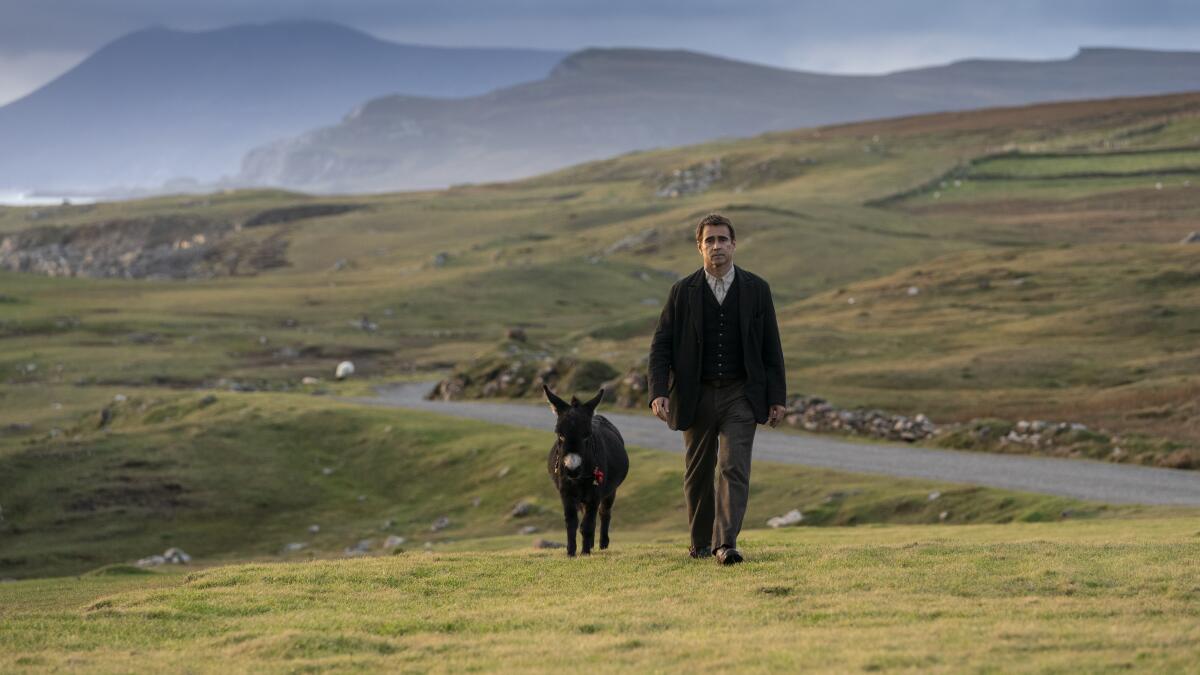
Incessant yammering, of course, is one unflattering if essentially correct way to describe McDonagh’s own flavorsome dialogue, which uses staccato rhythms and purposeful word repetitions to generate a sustained back-and-forth almost as musical as Carter Burwell’s lovely score. Apart from “feck,” the favored expletive of this early 20th century Irish milieu, the script’s most frequently deployed four-letter words are “dull” and “nice,” two words that are often hurled in Pádraic’s direction. Agreeable and simple-minded, Pádraic gets along with just about everyone, from his sharp-as-a-tack sister, Siobhan (a flat-out wonderful Kerry Condon), to the animals placed in his reliable care. (None of the latter is more beloved than his miniature donkey, Jenny, the most important member of the movie’s splendid four-legged ensemble.)
Colm’s rejection of Pádraic is also, in its way, a rejection of the tyranny of niceness, and an assertion that greatness — whether in the form of a Mozart symphony or, God willing, the humbler violin piece he’s trying to compose — is of far greater value. All of which opens up a rich, thorny dialogue concerning McDonagh himself, who likes to blur the lines between humanism and nihilism, and who in “The Banshees of Inisherin” comes perhaps as close to greatness as he’s ever gotten. One measure of the movie’s skill, and its generosity, is that it embraces the wisdom of both its protagonists. You’ll share Colm’s exasperation and defend his right to pursue an unimpeded life of music and the mind, but you’ll also concede Pádraic’s point that kindness and camaraderie leave behind their own indelible if often invisible legacies.
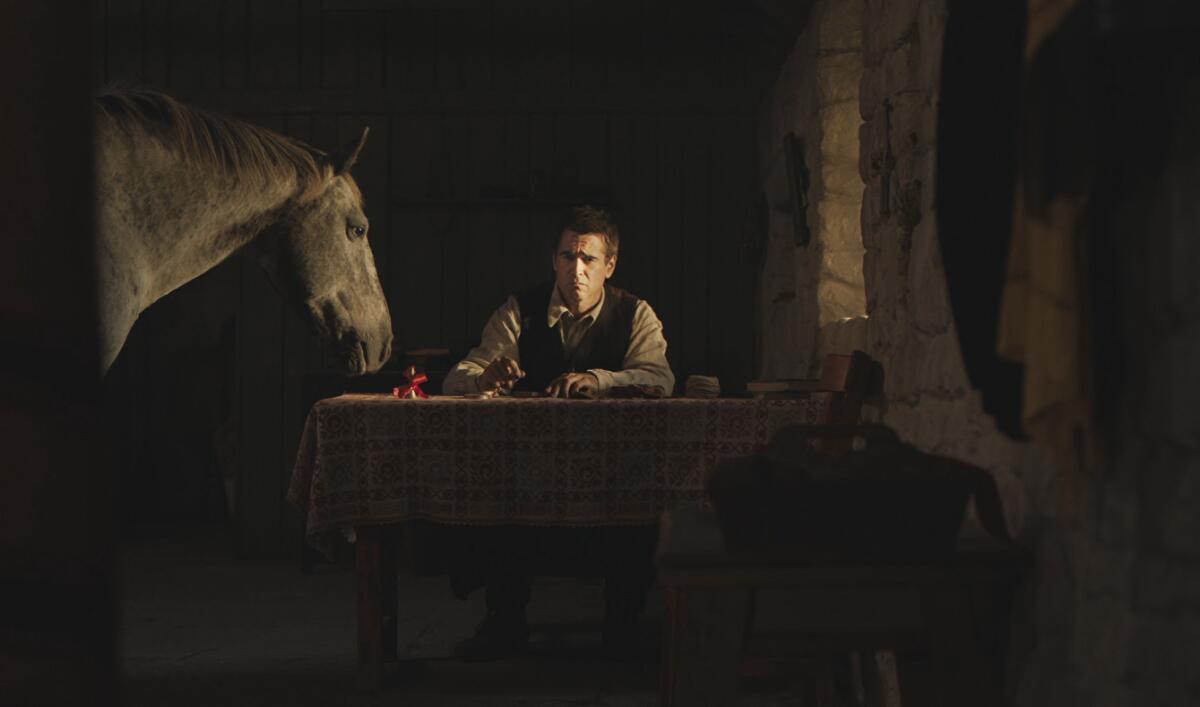
Muddying the waters still further: Colm, despite his strict enforcement of boundaries (including a not-so-idle threat to harm himself if Pádraic doesn’t leave him alone), nonetheless finds ways to treat his hapless former friend with decency and compassion. Meanwhile, Pádraic, for all his talk of niceness, is the one whose escalating harassment of Colm takes on menacing overtones, lubricated by whiskey, desperation and anger. To watch these two characters rage against each other is to acquire an entirely new understanding of what happens when an unstoppable force meets an immovable object. And no one ultimately understands that dynamic better than Siobhan, who — as both Pádraic’s loyal, loving sister and the one person on Inisherin who can keep intellectual pace with Colm — could hardly be more divided in her sympathies.
Siobhan’s presence — and her own fiercely individual decisionmaking — opens up another dialectic. Although centered on the conflict between two equally unyielding men, the movie is no less about the tension between a small, isolated community and the vast world that lies beyond its overcast horizon. Mocked by the provincial townfolk for being single and bookish, Siobhan is eyeing her own possible escape. And who can blame her? “The Banshees of Inisherin,” like much of McDonagh’s earlier work, uses its physically remote setting to map out an entire human cosmos of greed, spite and self-delusion, populated by characters including a gossipy shopkeeper (Bríd Ní Neachtain), a physically abusive policeman (Gary Lydon), a witchy prophesier of doom (Sheila Flitton) and, on the more likable side, a village idiot named Dominic (Barry Keoghan).
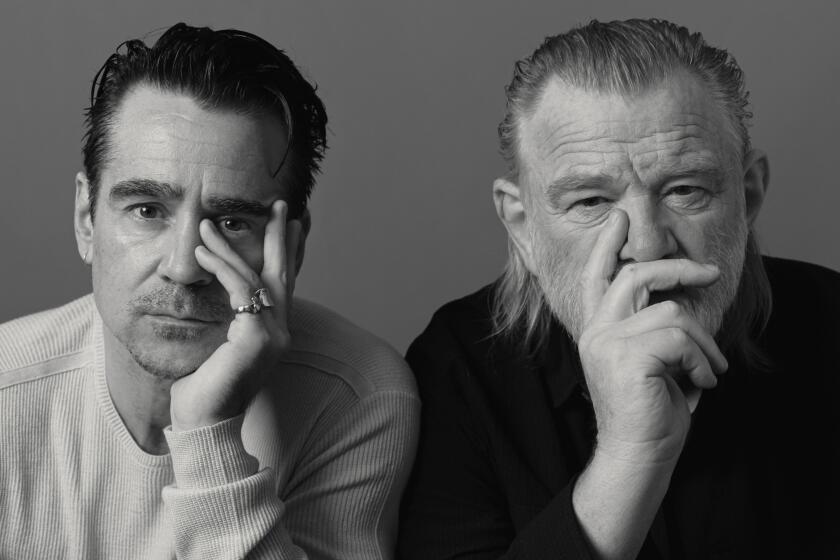
Colin Farrell doesn’t have many ‘true friends.’ But Brendan Gleeson is one
From ‘In Bruges’ to ‘Saturday Night Live,’ the ‘Banshees of Inisherin’ co-stars have never had a problem picking up where they left off.
Oct. 19, 2022
With the exception of Dominic, a perpetual troublemaker whom Keoghan invests with wit, mischief and unexpected pathos, none of these peripheral characters reveals more than one or two dimensions. If “The Banshees of Inisherin” marks a significant improvement on the wildly uneven “Three Billboards,” it still doesn’t entirely shake off some of the reflexively glib, cynical aspects of McDonagh’s writing, namely his tendency to reduce some of his characters to one-note personalities, or to make them the butt of cruel comic (and sometimes cosmic) punchlines. They are the playthings of a God who dispenses punishments with a whimsical, even arbitrary hand, and whom few of these habitual churchgoers — maybe not even the meddlesome priest (David Pearse) who’s enlisted to mediate the central conflict — ultimately really trusts or believes in.
And so Colm is only right to be consumed with despair. Which doesn’t make Pádraic wrong to assume that there are salves for life’s woes, and that he might, in fact, be one of them. Farrell’s performance, one of the finest he’s ever given, is a balm in itself, a thing of rough-hewn simplicity and exquisite delicacy, nailing comic beats and striking emotional chords with the same deft touch. Without ever turning leaden or oppressive, he shows us a man who isn’t the same by movie’s end, who’s experienced more loss, fury and grief than he’d ever thought possible. All he can count on anymore, really, is the ground beneath his feet — and in that respect at least, McDonagh suggests, he may be far less alone than he realizes.
‘The Banshees of Inisherin’
Rated: R, for language throughout, some violent content and brief graphic nudity Running time: 1 hour, 54 minutes Playing: Starts Oct. 21 at AMC the Grove, Los Angeles; AMC Century City
More to Read

Review: A rowdy Irish rap trio with a growing sense of purpose tells its own story in ‘Kneecap’
Aug. 2, 2024

Richard Gadd knew his ‘Baby Reindeer’ was dark. So was his life. Not anymore
July 30, 2024

‘Game of Thrones’ director accidentally lied to Obama about Jon Snow’s fate
July 29, 2024
Only good movies
Get the Indie Focus newsletter, Mark Olsen's weekly guide to the world of cinema.
You may occasionally receive promotional content from the Los Angeles Times.

Justin Chang was a film critic for the Los Angeles Times from 2016 to 2024. He won the 2024 Pulitzer Prize in criticism for work published in 2023. Chang is the author of the book “FilmCraft: Editing” and serves as chair of the National Society of Film Critics and secretary of the Los Angeles Film Critics Assn.
More From the Los Angeles Times

How powerful women in history informed Olivia Williams’ role in ‘Dune: Prophecy’
Nov. 7, 2024

Kristin Scott Thomas confirms secret wedding to Bloomberg News’ John Micklethwait
Nov. 6, 2024

Entertainment & Arts
Selena Gomez reveals health diagnosis in response to body shamers: ‘This makes me sick’
Nov. 5, 2024

Ariana Grande celebrates romance with co-star Ethan Slater as ‘Wicked’ premieres Down Under
Nov. 4, 2024
Most Read in Movies

Simu Liu asks fans to stop ‘bullying’ bubble tea brand amid ‘cultural appropriation’ stir
Oct. 14, 2024

Rachel Zegler says her ‘Snow White’ movie gives the princess’ name a new origin story
Oct. 2, 2024
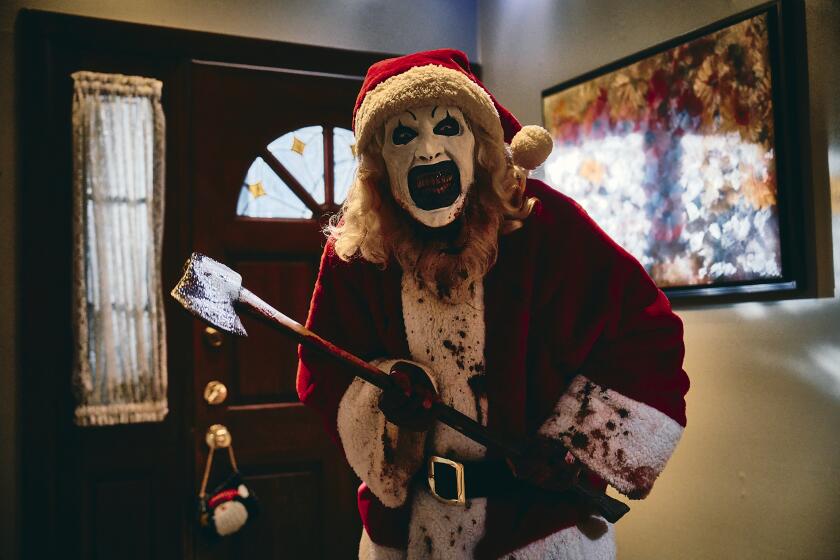
Commentary: How the merry gore of ‘Terrifier 3’ won over horror fans — and the weekend box office

Motion picture academy lays off staff at archive and library amid broader restructuring
Oct. 31, 2024
clock This article was published more than 2 years ago
‘The Banshees of Inisherin’: When old friendship goes violently awry
Colin Farrell and Brendan Gleeson reunite with ‘In Bruges’ filmmaker Martin McDonagh

The Irish writer-director Martin McDonagh has earned an adoring audience for his ability to find grace amid the grotesque. With films like “In Bruges” and “ Three Billboards Outside Ebbing, Missouri ,” he’s been rapturously received for his auteurist signatures, which include extravagant profanity, wickedly caustic humor, and a penchant for putting his characters into alternately amusing and excruciating extremes.
In other words, McDonagh is a master world builder. Whether you want to live in those worlds for two hours of your only life is purely a matter of individual taste. For some, McDonagh’s soaring vernacular and tightrope balance of cruelty and humanism embody the finest values of the Irish literary tradition. Others (present company included) find the verbal pyrotechnics clever distractions from a facile, supremely ungenerous moral imagination. Put simply, some of us aren’t buying it.
“The Banshees of Inisherin,” McDonagh’s latest portrait of human frailty taken to its most perverse lengths, finds the filmmaker in a gentler allegorical space than his previous films; the opening scene features a literal rainbow behind his protagonist’s shoulder. But viewers shouldn’t mistake the story’s fairy-tale-like contours for reassurance. It’s still McDonagh’s world, shot through with rhetorical curlicues, unfettered absurdism, and lashings of sudden, lacerating violence.
All those values are on showy display in “The Banshees of Inisherin,” which reunites “In Bruges” stars Colin Farrell and Brendan Gleeson, this time not on a hit job in Belgium but on the fictional Irish island of Inisherin in 1923. Farrell plays Padraic Suilleabhain, a simple villager who lives with his sister Siobhan (Kerry Condon) and enjoys regular nights at the local pub with his best friend Colm (Gleeson). As “The Banshees of Inisherin” opens, Colm is behaving strangely toward Padraic; if it were the present day, we’d say he was ghosting his former wing man. In 1920s Ireland, with the civil war barely detectable in the distance, the rejection is far less passive-aggressive: Colm would sooner cut off a finger than indulge Padraic’s entreaties of friendship. Literally.
Can this bromance be saved? “The Banshees of Inisherin” escalates with hyperbole typical of McDonagh: As Padraic’s irresistible force repeatedly butts up against Colm’s immovable object, only hilarity or tragedy can ensue. Make that hilarity and tragedy, as is McDonagh’s wont, as a number of subplots unfurl to underline the filmmaker’s fundamental themes, including the travails of a slow-witted townsman named Dominic (Barry Keoghan) and the sadistic predations of his abusive father, who happens also to be the local policeman.
For the frequent blunt-force meanness and operatic emotion of the story, “The Banshees of Inisherin” looks beautiful: Cinematographer Ben Davis infuses the County Mayo locations with an otherworldliness appropriate to the story’s intimations of mysticism and romance. If Keoghan’s depiction of a developmentally delayed character veers uncomfortably close to caricature, Farrell, Gleeson and Condon are all sharply compelling as the three main characters, with Condon acquitting herself with particular aplomb as an intelligent woman forced to navigate man feelings writ irrationally, self-importantly large.
Presumably, one of McDonagh’s themes is the fatal cost of masculine reserve, as well as the futility of petty squabbles that can so easily metastasize into the fraternal battles that rage beyond Inisherin’s sleepy shores. “The Banshees of Inisherin” is also about artistic ego at its most monstrous and selfishly all-consuming: Colm’s reason for excising Padraic from his life is so that he can spend his final years focusing solely on playing the fiddle and composing (the piece he’s working on is called “The Banshees of Inisherin”). McDonagh sets up a central dynamic that’s seductive in its binary simplicity: What’s more important, to be loved or to be great? To be smart or to be kind? Nice or interesting?
The fact that the choice is a false one is but a quibble within the filmmaker’s larger project, which is to put his characters in a purgatory of his own making and prod them while they squirm. It’s possible to see why McDonagh’s fans love his quirks and clever structural feints (the war of wills in “Banshees” often plays out like variations on a theme), as well as his characters’ willingness not to be liked. But what they find at the end of the filmmaker’s rainbow is less likely to be a pot of philosophical gold than prosaic self-satisfaction. “I just like the double ‘sh’ sound,” Colm says, explaining the title of his masterwork. He could just as well be speaking for McDonagh himself.
R. At area theaters. Contains strong language throughout, some violence and brief graphic nudity. 114 minutes.

The Banshees Of Inisherin Review
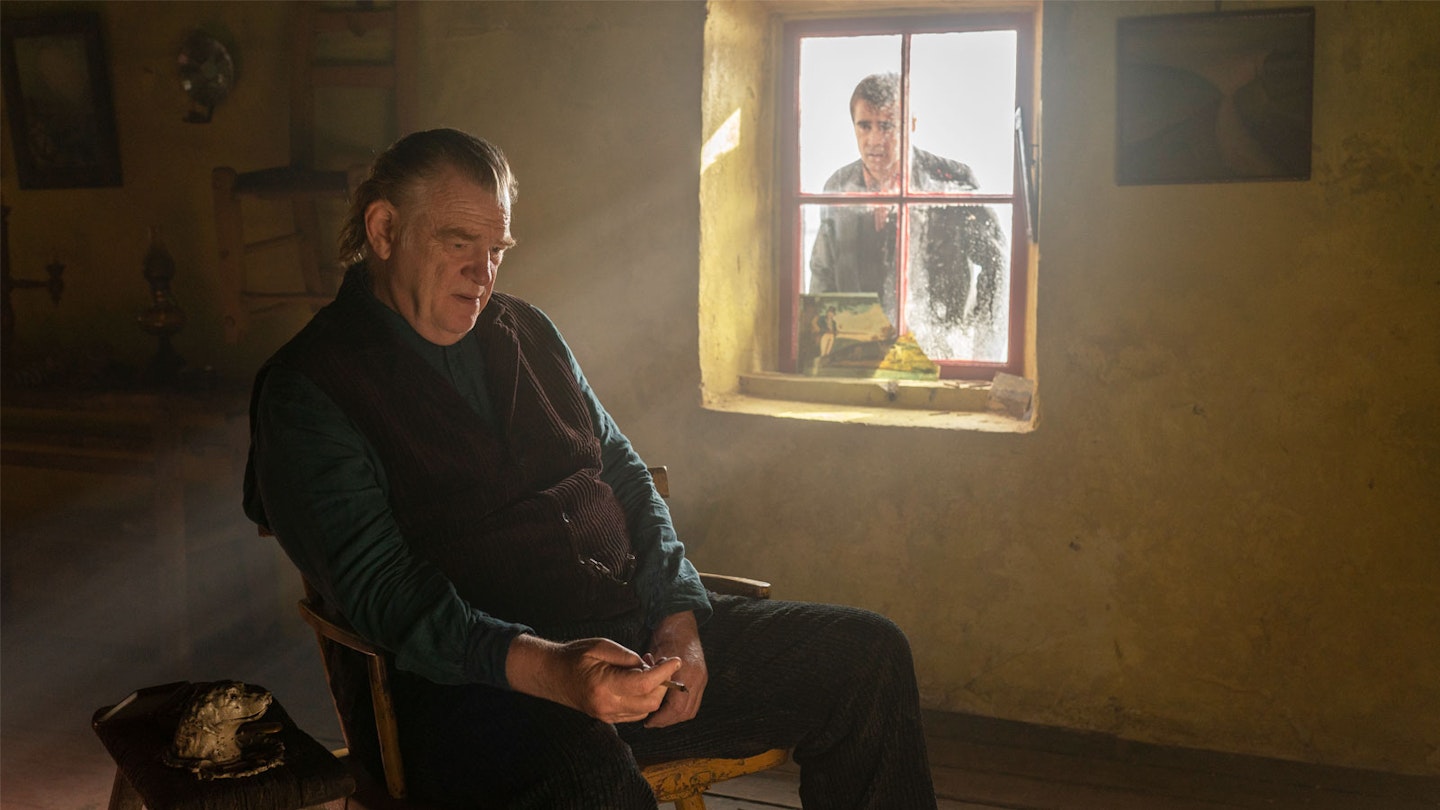
21 Oct 2022
The Banshees Of Inisherin
How do you break up with a best friend? It’s a good question, tackled brilliantly by Seinfeld way back in its first season. After all, the rules of social disengagement are pretty clear when it comes to sexual relationships, even more so when they involve divorce. But separating from a buddy you just don’t like anymore? When the pair of you live on a small, scantily populated island with only one pub? How do you go about that?
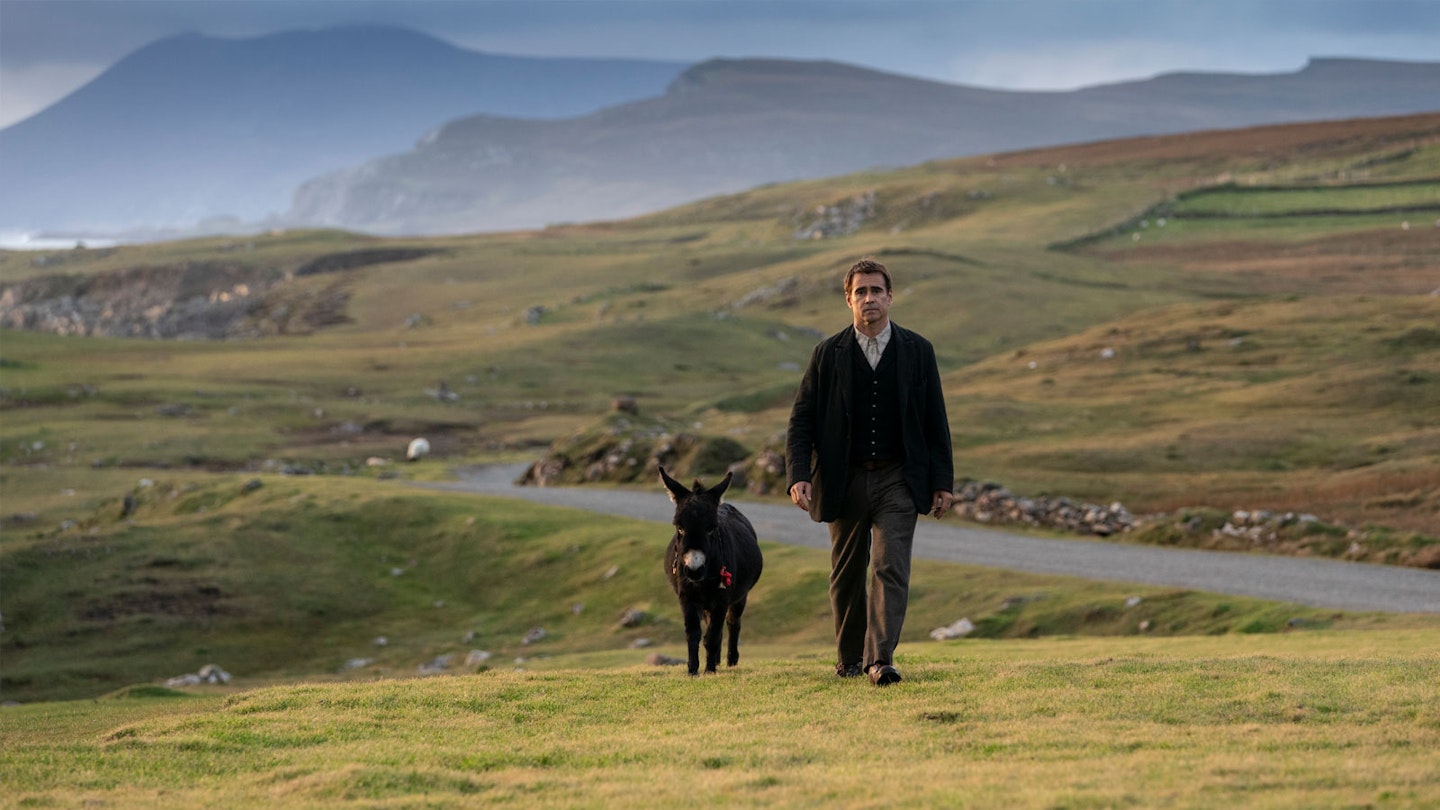
In Martin McDonagh ’s world, the answer is: brutally. After resolving to dissolve his friendship with the dependable but dull Pádraic ( Colin Farrell ), Colm ( Brendan Gleeson ) bluntly tells his ex-friend he doesn’t want talk to him or drink with him ever again. No explanation given. No attempt made to soften the blow. Of course, if you’re familiar with writer-director McDonagh’s previous film work, from In Bruges to Three Billboards Outside Ebbing, Missouri , such tactlessness should come as no surprise — McDonagh’s scripts are so abrasive, you could use them as sandpaper. So the focus of the film is less on Colm’s decision, and more on Pádraic’s reaction, not to mention the impact it has on his “limited” (another character’s word, not ours) life.
Farrell is fantastic, delivering one of his best-ever performances.
Ironically, for a story about a friendship-wreck, The Banshees Of Inisherin is also a reunion: of McDonagh with the double act that made the hitman antics of In Bruges such a piquant treat. However, Farrell and Gleeson don’t spend nearly as much time on screen together here, for self-evident reasons. It’s a shame, in a small way, but it does add to the pervading sense of wrongness.
Colm is largely inscrutable, despite the occasional revelation of sorts, and the odd flash of kindliness. McDonagh never fully reveals what drives him to the Pádraic-alienating extremes he goes to later in the film, and that makes him the more emotionally distant of the two men.
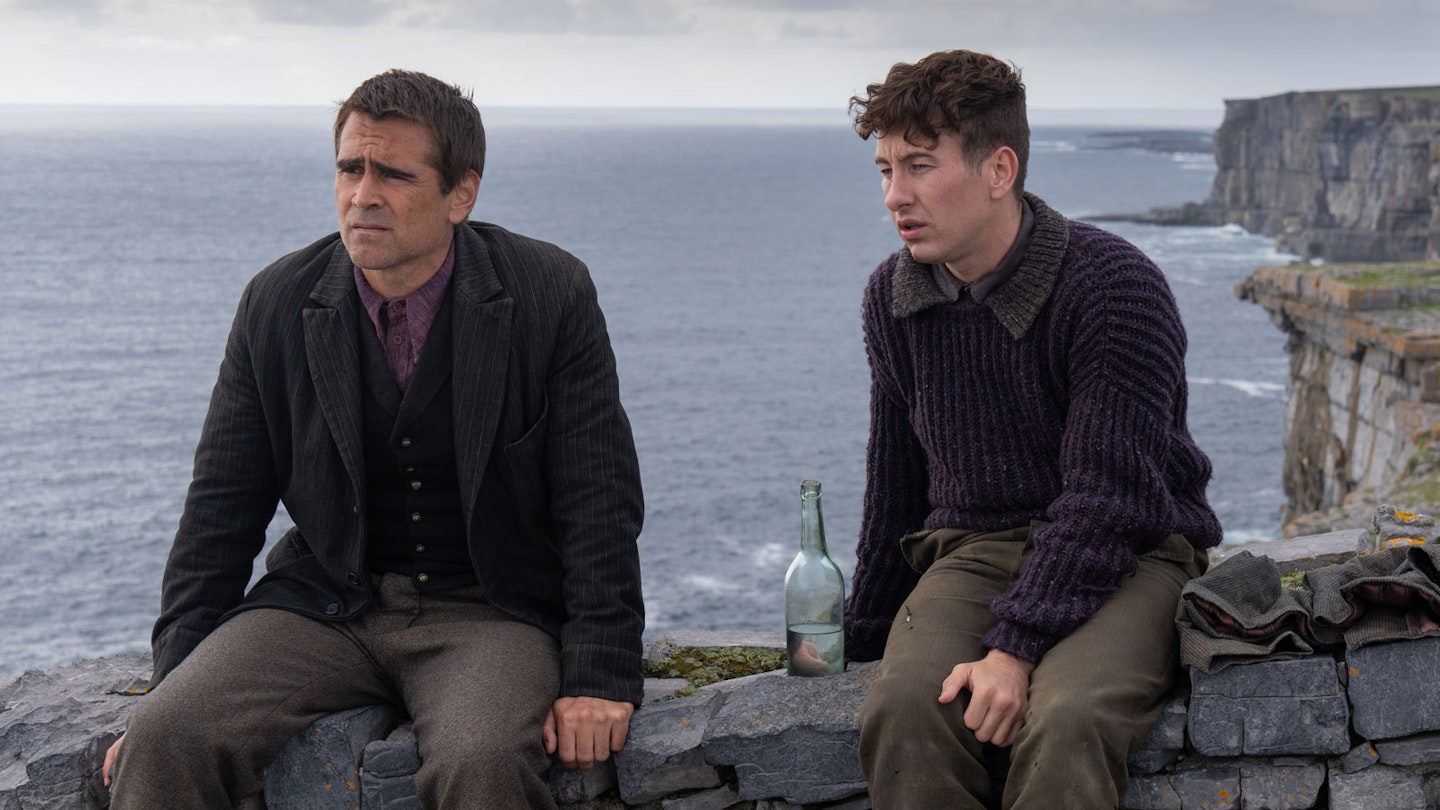
This is primarily Pádraic’s story; the tale of a good, decent fella who, through an enforced process of self-examination, finds and embraces other, sharper facets to his personality. Farrell is fantastic in the role, delivering one of his best-ever performances. He takes on a kind of sagging anti-charisma, a seeming guilelessness which he initially plays for laughs, but then gradually and convincingly brews into something much darker.
Complementing him perfectly is Kerry Condon as Pádraic’s savvy sister, Siobhan. Her exasperation at her brother’s response to Colm’s ultra-dick move is thoroughly relatable, and you’ll welcome every moment she spends on screen. Siobhan also evokes the most sympathy as a woman who has clearly, desperately outgrown this cliff- edged, wall-scarred speck of an island — a realisation only underlined by the clumsy amorous attentions of Barry Keoghan’s damaged youth, Dominic, a character that sadly gets the shortest narrative shrift of the bunch.
The drama may be intimate, but the backdrop feels epic.
Tenderly scored by Carter Burwell and gorgeously shot by cinematographer Ben Davis — the drama may be intimate, but the backdrop feels epic — The Banshees Of Inisherin is a film whose unhurried pace never drags. It is, we suppose, McDonagh’s gentlest offering yet (and the fact that his gentlest film involves acts of mutilation says a lot about his other work). That said, you could also argue it is his first war movie. And not just because it is set during the Irish Civil War of 1922-23, which is heard raging just a few miles across the water. After all, Colm and Pádraic’s split is really just that war in microcosm. The causes are obscure and confusing, the emerging conflict escalates fast, the previously close participants employ tactics that would have once been unthinkable. And the after-effects will be felt for years to come.
McDonagh has never been one for neat resolutions, so it’s not giving anything away to say that we’re denied one here, too. This is no bromantic-comedy, and you really shouldn’t be hoping for any feel-good vibes (though there are plenty of laughs, if your humour verges on the dark side). But the film is engrossing and beautifully mounted, and is sure to not disappoint anyone who’s enjoyed McDonagh’s previous rough rides.
Related Articles

Movies | 29 08 2024
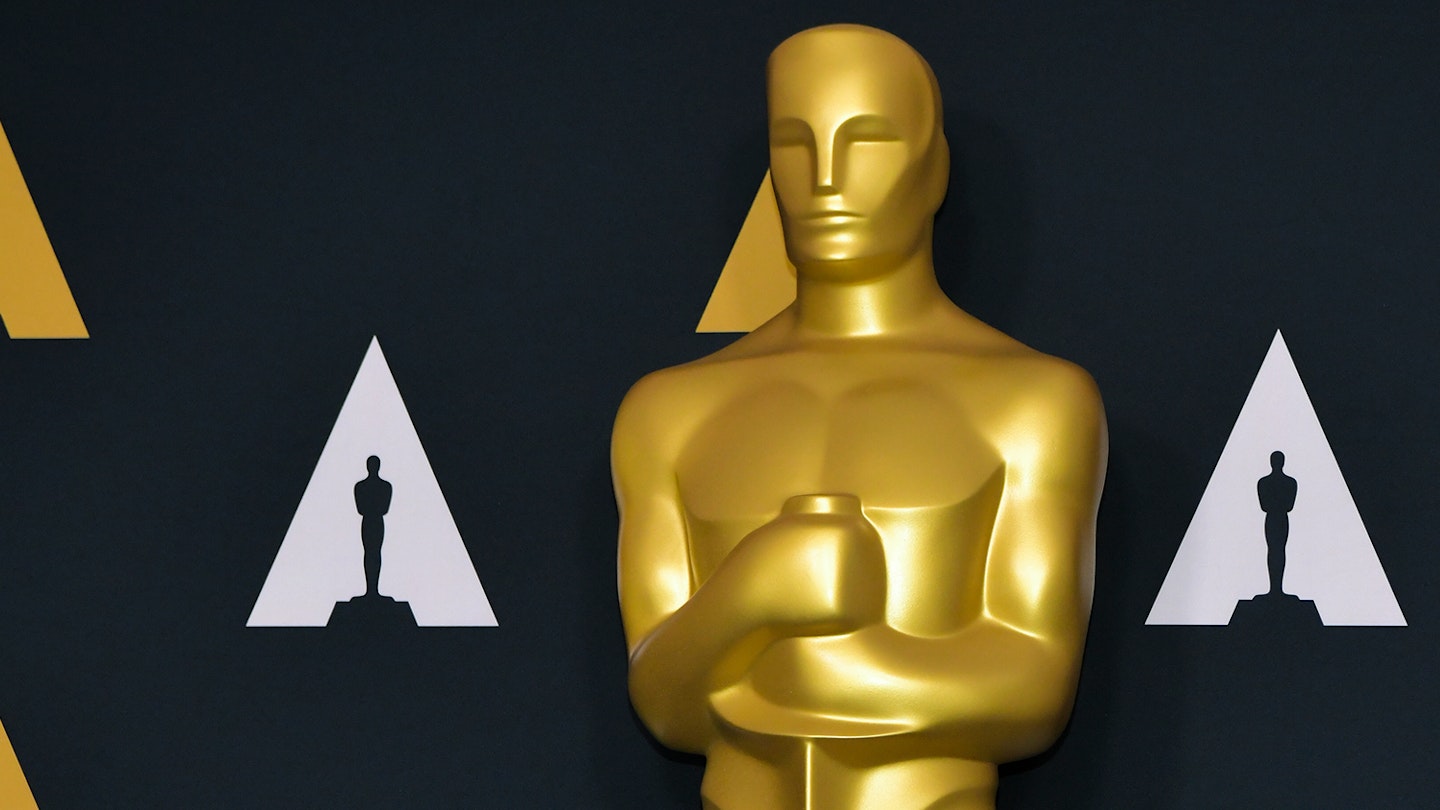
Movies | 12 03 2023
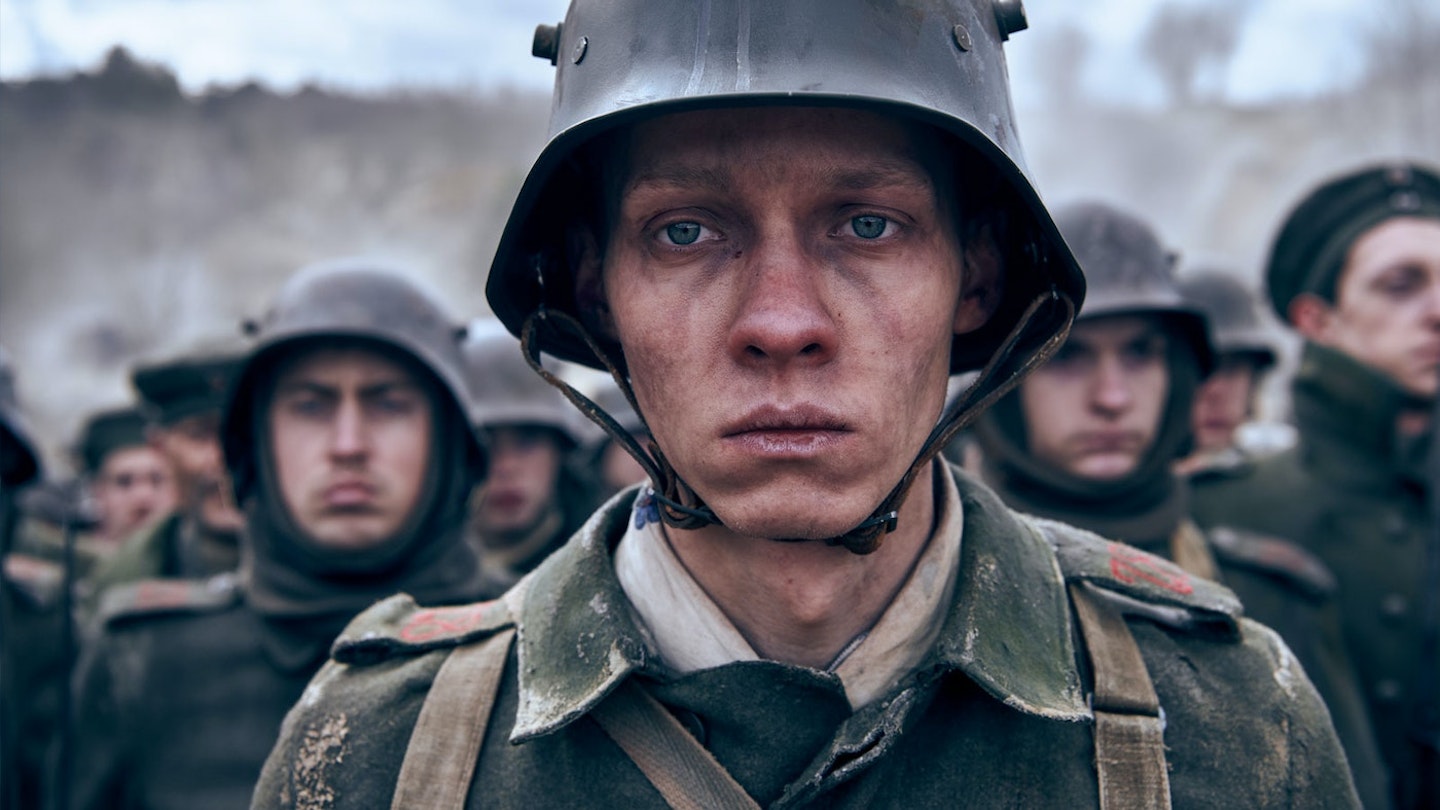
Movies | 19 02 2023

Movies | 06 02 2023
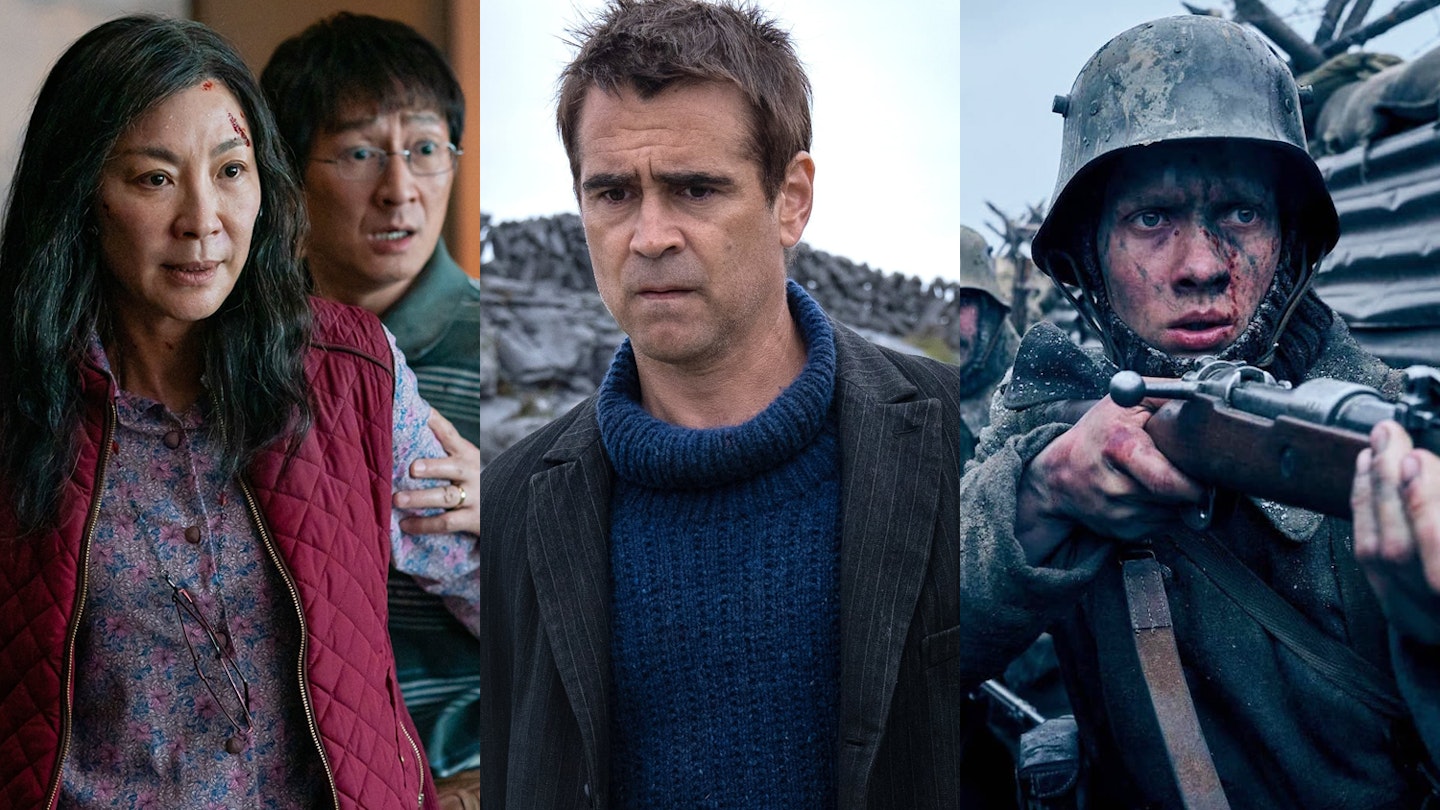
Movies | 19 01 2023

Movies | 02 12 2022

Movies | 28 09 2022
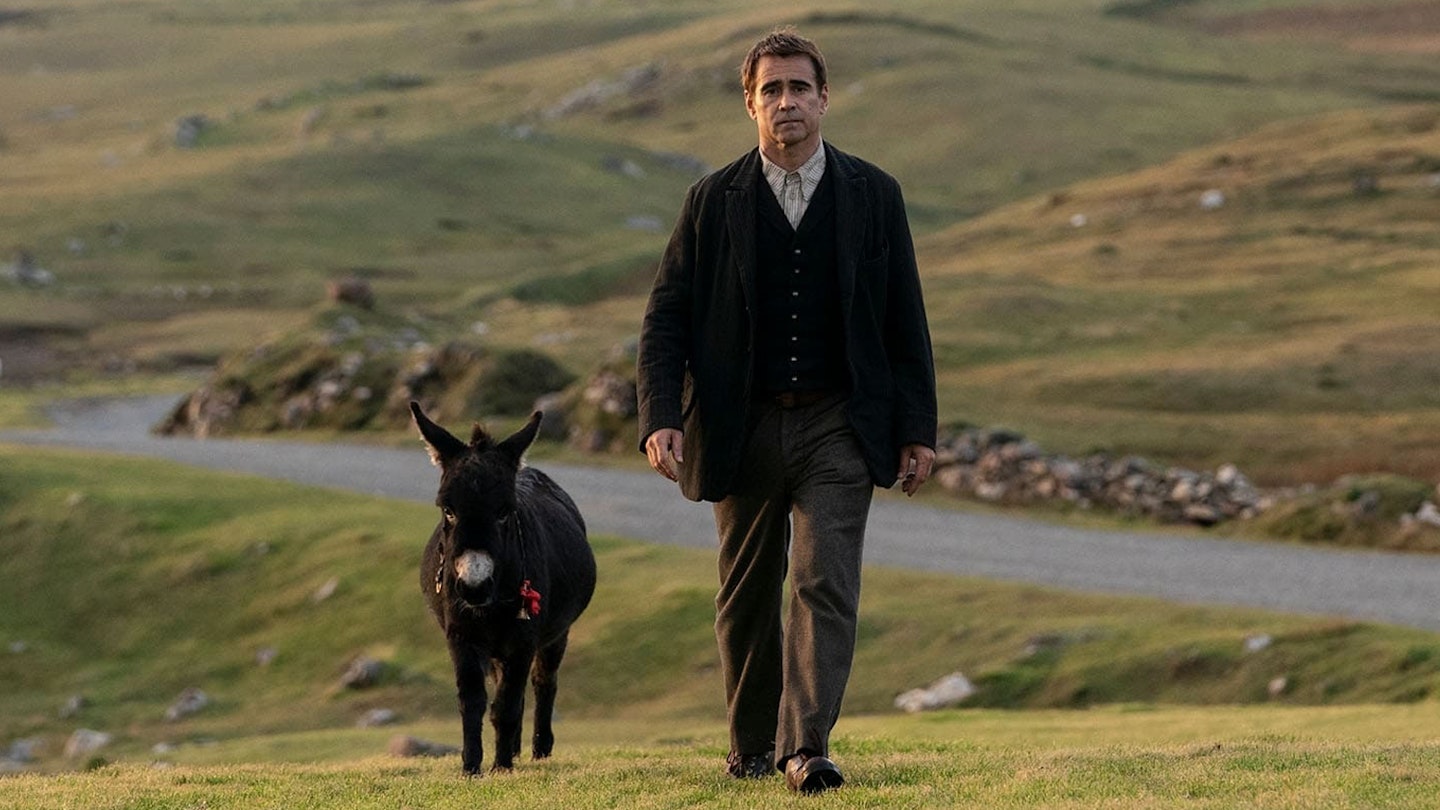
Movies | 27 09 2022
- Stranger Things Season 5
- Deadpool and Wolverine
- The Batman 2
- Spider-Man 4
- Yellowstone Season 6
- Fallout Season 2
- The Last of Us Season 2
- Entertainment
The Banshees of Inisherin review: The best breakup film of the year
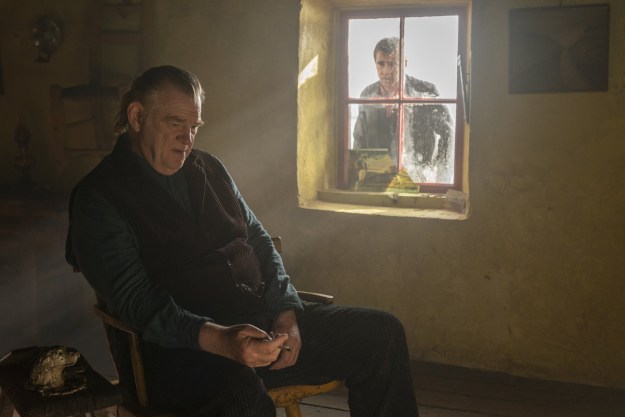
“The Banshees of Inisherin is not only the year’s greatest breakup film, but also an appropriately thorny follow-up to In Bruges, the acclaimed drama that first brought Gleeson, Farrell, and McDonagh together.”
- Martin McDonagh's unpredictable, emotionally involving script
- Colin Farell's career-best performance
- Brendan Gleeson, Barry Keoghan, and Kerry Condon's stunning supporting performances
- Slightly too long
- A few too many tourist ad-esque shots of Ireland
- An ending that may be too ambiguous for some viewers
Early on in The Banshees of Inisherin , the brilliant new film from writer-director Martin McDonagh, Siobhán (Kerry Condon) asks her brother, Pádraic (Colin Farrell), a question that’s clearly been on her mind for a long time. “Do you ever get lonely, Pádraic?” she asks. “Do I ever get lonely? Do I ever get lonely ? What is with everyone today?” Pádraic responds shortly before storming out of the room. He, notably, doesn’t answer Siobhán’s question. Maybe it’s because he doesn’t know how to answer it. Or maybe it’s because the answer is obvious — so obvious, in fact, that there’s no point in even asking. Of course , Pádraic gets lonely. Who wouldn’t be on a small Irish island like Inisherin?
Breaking up is hard to do
A pair of terrific lead performances, a fully realized irish world.
For Pádraic, the inherent loneliness of his home has largely been kept at bay by one thing: his long-standing friendship with Colm Doherty (Brendan Gleeson), a talented violinist. Pádraic’s life is turned upside down, however, when Colm decides at the start of The Banshees of Inisherin that he no longer wants to be friends with Farrell’s oblivious, simple-minded farmer. The decision, which is born out of seemingly nothing more than Colm’s own dissatisfaction with his life, forces both he and Pádraic to face the parts of themselves and their lives that they’ve either never noticed or long chosen to ignore.
- This new slow-burn thriller features one of 2024’s best performances
- 10 best Netflix movies to watch on New Year’s Day
- Where to watch The Banshees of Inisherin
What emerges from these reckonings is not only the year’s greatest breakup film, but also an appropriately thorny follow-up to In Bruges , the acclaimed drama that first brought Gleeson, Farrell, and McDonagh together. Here, in his latest outing, McDonagh uses the disintegration of a single friendship to touch on everything from the Irish Civil War to the ways in which mental illness often affects not just one person, but those they love as well. Not since their previous collaboration have Gleeson, McDonagh, and Farrell dealt with such emotionally visceral, delicate material, but all three emerge from The Banshees of Inisherin more accomplished than they were before.
Set in the early 1920s, The Banshees of Inisherin takes place during a time when Ireland is still in the midst of its infamous civil war. Despite that fact, the only signs of war that ever seem to reach the residents of The Banshees of Inisherin ‘s central island are the occasional booms of canons and the thin pillars of smoke that can be seen from across the sea. While these traces of bloodshed linger ominously in the air as well, the violence of the war itself has, nonetheless, not yet come to the shores of the film’s eponymous island when The Banshees of Inisherin begins.
That all changes when Gleeson’s Colm decides to terminate his friendship with Farrell’s Pádraic. The latter, understandably, doesn’t take Colm’s decision well. However, when Pádraic repeatedly demands to hear a reasonable explanation for his friend’s change of attitude, Colm comes up with a brutal ultimatum: Every time Pádraic bothers Colm, he will cut off one of his own fingers. The only way for Pádraic to avoid bloodshed is, therefore, to totally cut himself off from Colm.
Like so many of McDonagh’s best dramatic inventions, Colm’s ultimatum pulses with the threat of both inward and outward violence. McDonagh, for his part, never outright explains the feelings and thoughts that led Gleeson’s Colm to such a bitter, violent mental space, either. The writer, instead, lets Colm’s actions speak for themselves, and his decision to threaten to harm himself instead of Farrell’s Padraic ultimately tells us everything we need to know about Colm’s personal issues.
Both Colm and Pádraic are, in many ways, sketched very thinly by McDonagh. In the hands of lesser performers, they might have even come across as one-note. While Gleeson and Farrell don’t, by any means, paint outside the lines of McDonagh’s original sketches, either, they do fill them up with enough color to turn both Colm and Pádraic into two of the most memorable characters you’ll likely see on-screen this year.
McDonagh’s familiarity with Gleeson and Farrell also allows him to play to each of their strengths. Gleeson’s ability to seem composed even in the face of absolute chaos has, for instance, helped him hone a uniquely commanding screen presence over the years. Here, however, Gleeson’s steadfast composure is used to devastating effect once it becomes clear that Colm’s assured, calm demeanor is nothing more than a thin veil meant to cover up his own sense of wayward hopelessness. Opposite him, Colin Farrell taps into the same kind of emotional volatility that McDonagh spotlighted when they worked together nearly 15 years ago on In Bruges .
In a sense, Farrell’s turn in The Banshees of Inisherin even feels like an inverse of his In Bruges performance. That 2008 drama saw Farrell play a character whose initial harshness and cruelty eventually fell away to reveal the depression and guilt that had been tormenting him all along. Here, in The Banshees of Inisherin , Pádraic’s innocence is gradually chipped away until all that remains is his own bitterness and anger. The character’s transformation is alternatively heartbreaking and horrifying to watch, and Farrell makes the most of it, turning in a performance that might very well be the best of his career so far.
Outside of Gleeson and Farrell, Kerry Condon and Barry Keoghan turn in two stunning performances as The Banshees of Inisherin ‘s primary supporting figures. As Siobhán, Pádraic’s sister, Condon serves as the steady, sole voice of reason amid the growing chaos caused by Colm and her brother’s unnecessary feud. Keoghan, meanwhile, cements himself yet again as one of Hollywood’s most exciting young performers with his turn as Dominic, a town pariah whose brash personality has created a painful divide between him and many of Inisherin’s other residents.
Together, Keoghan, Condon, Farrell, and Gleeson breathe real life into The Banshees of Inisherin ’s isolated and humorous, if often melancholic, world. As a film about two friends who are suddenly and violently ripped apart by their own hang-ups, McDonagh’s latest is, much like the characters within it, a heart-wrenching, relentlessly honest piece of work. It’s not just Colm and Pádraic’s friendship that McDonagh has on his mind in The Banshees of Inisherin , though.
While Inisherin itself may seem to exist in its own little world, McDonagh makes it clear that the island isn’t free of the same problems that have plagued humanity for centuries. That point is never better made than in The Banshees of Inisherin ‘s third act when McDonagh briefly shows Farrell’s Pádraic watching silently as distant pillars of smoke billow up into the air. They look strikingly similar to the ones that Pádraic saw near the start of the film, but unlike those, which belonged to Ireland’s mainland, these new plumes of smoke are coming from the same space as a nearby Inisherin homestead. Violence, it turns out, has a way of leaving its marks on even the loneliest of places.
The Banshees of Inisherin hits theaters on Friday, October 14.
Editors’ Recommendations
- 10 best movies of the 2020s (so far), ranked
- Like the Best Picture Oscar nominee Killers of the Flower Moon? Then watch these 3 great films
- 3 best (HBO) Max movies you need to watch on New Year’s Day
- Rosaline review: Kaitlyn Dever lifts up Hulu’s Romeo and Juliet rom-com riff
- Decision to Leave review: An achingly romantic noir thriller
- Product Reviews

Amsterdam could have been forgiven for being a lot of things, but dull is not one of them. The new film from writer-director David O. Russell boasts one of the most impressive ensemble casts of the year and is photographed by Emmanuel Lubezki, one of Hollywood’s premier cinematographers. Beyond that, its kooky premise and even wackier cast of characters open the door for Amsterdam to be the kind of screwball murder mystery that O. Russell, at the very least, seems uniquely well-equipped to make.
Instead, Amsterdam is a disaster of the highest order. It’s a film made up of so many disparate, incongruent parts that it becomes clear very early on in its 134-minute runtime that no one involved — O. Russell most of all — really knew what it is they were making. It is a misfire of epic proportions, a comedic conspiracy thriller that is written like a haphazard screwball comedy but paced like a meandering detective drama. Every element seems to be at odds with another, resulting in a film that is rarely funny but consistently irritating.
“Had she said no, the film would never have seen the light of day,” director Todd Field said in a statement about his ambitious new drama, Tár. He was, of course, talking about the film’s star, Cate Blanchett, whose reputation as one of Hollywood’s greatest living actresses certainly precedes her at this point. Despite that fact, it would be easy to initially shrug off Field’s comment as nothing more than a pandering or superficial remark. After all, what director wouldn’t say that about the lead star of their film, especially someone of Blanchett’s caliber?
Having seen Tár, though, the truth of Field’s comment is undeniably clear. In order for it to cast any kind of spell, Tár requires a performer with Blanchett’s charismatic, towering presence. It demands someone who can not only disappear into a character, but who can do so and still be able to command every scene partner who has the misfortune of being pitted against her. Blanchett does that and more in Tár.
Vesper does a lot with a little. Despite being made on an obviously lower budget than most other modern sci-fi movies, the new film from directors Kristina Buozyte and Bruno Samper takes place in a futuristic, post-apocalyptic world that feels more well-realized, vivid, and imaginative than any of Hollywood’s current cinematic universes do. While its premise doesn’t do much to sell Vesper as a unique entry into the dystopian sci-fi genre, either, it doesn’t take long for its fictional alternate reality to emerge as a striking new vision of the future.
The film's opening shot throws viewers headfirst into a swampy, gray world that seems, at first, to be perpetually covered in fog. It's an image that makes Vesper’s connections to other industrialized sci-fi films like Stalker undeniably, palpably clear. However, once Vesper escapes the foggy wasteland of its opening scene, it begins to flesh out its futuristic reality with rich shades of greens and colorful plants that breathe and reach out toward any living thing that comes close to them. While watching the film does, therefore, often feel like you’re being led on a tour through an industrial hellscape, it also feels, at times, like a trip down the rabbit hole and straight into Wonderland.
- Search Please fill out this field.
- Newsletters
- Sweepstakes
- Movie Reviews
The Banshees of Inisherin review: A friendship turns into a feud overnight
Colin Farrell and Brendan Gleeson are best friends suddenly on the outs in Martin McDonagh's brilliant, serrated black comedy.
:max_bytes(150000):strip_icc():format(webp)/image001-1-96bff255cc7d4c8da59d9d4192867e86.jpg)
It's been nearly 15 years since Martin McDonagh made his feature directorial debut with In Bruges , a neat, nasty little gem of a movie about two bungling hitmen ( Colin Farrell and Brendan Gleeson ) on the lam — and not doing it well — in Belgium. The Banshees of Inisherin reunites him with his two leading men in a film that turns out to be pretty much the furthest thing from a sequel to Bruges , but still feels like a kind of homecoming nonetheless. And a testament, too, to how they've each evolved as artists: A prolific playwright whose last screen outing, Three Billboards Outside Ebbing, Missouri, won Oscars for both Frances McDormand and Sam Rockwell, McDonagh has always been known for his particular brand of bleak existential comedy. Tar-black, bloody, and tinged with the surreal, it can also come off as ruthless, even casually cruel. Inisherin , though, feels like his most humane and deeply felt offering to date — which says a lot about a movie rife with blasphemy, self-mutilation, and miniature donkeys — and the actors here respond accordingly with some of the richest, most fully realized performances of their careers.
It's 1923 on a small windblown island off the coast of Ireland, and Pádraic (Farrell) seems like a happy-enough creature of habit: He lives in a modest cottage with his wry, bookish sister, Siobhán ( Better Call Saul 's Kerry Condon), tends to a small stable of animals, and meets his best mate Colm (Gleeson) regularly for pints at the local pub. That is, until the day Colm announces that he no longer wants to get pints, ever again. Life is too short, and Pádraic is too dull; Colm would prefer to be left alone with his dog and his fiddle, and maybe write a piece of music that actually means something before he dies. This abrupt change of heart isn't just bewildering for Pádraic, it's entirely destabilizing. Who is he, if not the man who gets pints with Colm?
Banshees , with its Kelly-green vistas, warbled shanties, and blithe obscenities ("feck" is a noun, an adjective, and sometimes a verb),could easily come off as the kind of Irish burlesque we've seen many times before; instead, the movie turns out to invert cliché as much as it embraces it. Inisherin may not be a hotbed for making new friends, but it's still a place rife with outsize characters: the local "idjit," Dominic ( Dunkirk 's puckish Barry Keoghan ) and his abusive constable father (Gary Lydon); the blustery parish priest (David Pearse); an elderly neighbor so wizened and witchy she looks like she might have once shared a staff with Gandalf. Their dialogue unfurls in Mcdonagh's signature rhythms, a sort of profane poetry that skitters between farce and calamity, often within the same sentence.
The cast tasked with it is masterful, from Keoghan's holy fool to Condon's long-suffering Siobhán, a nervy, sharp-witted woman stranded in a sea of petty grievances and grown adolescents. Farrell — alternately bruised, defiant, achingly sincere, and also very funny — wears the sum of his years here with fresh significance; he's still almost obscenely handsome, but there's a depth of feeling that could only come from lived experience, and a tender, shaggy gravitas in Gleeson too. Their falling out, of course, is not just about pints, or Pádraic's little house donkey that he keeps by his side like a border collie. To be corny, which the film (due in theaters Oct. 21) is decidedly not, it's about life: the brevity of it, the risks we do or don't take, who we choose to share it with in the end. And for all the gall, absurdity, and outright threats of physical violence, it's pretty feckin' wonderful. Grade: A–
Related content:
- 2023 Oscars heat index: Brendan Fraser, Cate Blanchett bound ahead as major acting contenders
- The mightiest movies at the 2022 Toronto International Film Festival
- The Whale review: Brendan Fraser shines in a overwrought, underbaked drama
- Causeway review: Jennifer Lawrence and Brian Tyree Henry find loneliness together in a modest, moving indie
Related Articles
‘The Banshees of Inisherin’: Colin Farrell, Brendan Gleeson Turn a Buddy Tragedy Into a Masterpiece
- By David Fear
“I just don’t like ya no more.”
Then, one day, Pádraic leaves the modest house he shares with his sister, Siobhan (Kerry Condon), and his cow herd, and Jenny the miniature pet donkey, and goes to fetch his drinking companion. There’s no answer to his knock. He spies Colm through the window, sitting alone, smoking. Confused, the man ambles down to the tavern by himself. “Have you been rowin’?” asks the bartender. “I don’t think we’ve been rowin’,” Pádraic replies. When he finally catches up to Colm at the bar, his pal tells him to sit somewhere else. What’s going on, the younger man wants to know. And then Colm says the seven words that will cost these two gents a lot more than just their friendship.
Editor’s picks
The 100 best tv episodes of all time, the 250 greatest guitarists of all time, the 500 greatest albums of all time, the 200 greatest singers of all time, related content, 'smile 2' proves there's nothing scarier than pop stardom, 'rumours' imagines world leaders in love, lust, and lost in the woods. we think it's fictional, is 'it's what's inside' as clever as it thinks it is, kris kristofferson was the gravelly voice of a generation — and the real deal onscreen, trending stories, republicans celebrate by admitting they can't wait for project 2025, after trump victory, seth meyers has just three words, jimmy kimmel holds back tears as he reflects on 'terrible' election results, why kamala harris lost — and why it wasn’t close.
McDonagh also wants to give his actors a hell of a showcase, too, and it’s the two stars butting brows at the center of The Banshees of Inisherin that make this a masterpiece of men behaving very feckin’ badly. We don’t want to ignore the great work that Keoghan or Condon are doing on the periphery, or the exquisite cinematography by Ben Davis, or Carter Burwell’s ability to channel both regional folk music and a universal sense of grief in his score. It’s just that the Farrell-Gleeson Blues Explosion is what grounds McDonagh’s heady notions and fuels its fire.
There’s such an incredible give and take between these two, and while we’ve been taking Gleeson’s off-kilter charisma for granted since 1998’s The General, the performance that leaves scars is Farrell’s. It’s tough to think of a portrayal that finds so many emotional shades and levels of depth in incomprehension; his Pádraic can’t grasp the logic behind his friend’s decision any more than he can control his reactions, his sudden neediness or the shame that he’s done something wrong by doing nothing much with his life. You also see why a friend might be tempted to back away from him as well, yet you never feel that Farrell is tipping his hand toward sympathy or antipathy for this remarkably simple soul. It’s not a coincidence that the two men give the film’s ending a sense of ambiguity regarding what might happen after the credits role. Yet it’s also not a mistake that Farrrell is the one who gets the final shot, and that he’s the fella who leaves you with the sense that you’ve just witnessed wounds that may never heal. May the Banshees shriek for this duo forever. As for McDonagh: Welcome back.
‘Jeopardy!’ Contestant Says Sexist Clue Made Everyone in the Room 'A Little Uncomfortable'
- Killed the Vibe
- By Larisha Paul
'Bird' Is a Coming-of-Age Movie of a Different Feather
- MOVIE REVIEW
Jimmy Kimmel Holds Back Tears as He Reflects on 'Terrible' Election Results
- Late-Night TV
- By Emily Zemler
- Challenge Accepted
- By Charisma Madarang
Niecy Nash-Betts Is ‘Not a One-Trick Pony’
- guts and glory
- By Kalia Richardson
Most Popular
'joker' director todd phillips tells movie theaters to 'stop showing commercials' before films: 'they take the air out of the room', hollywood reacts to second trump presidency win: "a sign of deep nihilism", 178 amazon favorites that have earned a spot in everyone's cart, dj envy hit with the side-eye after daughter dresses as "crush on you" lil kim for halloween, you might also like, joe biden pledges peaceful handoff of power back to donald trump: ‘we’re going to be ok’, michèle lamy’s candle looks artfully melted even before you light it, the best yoga mats for any practice, according to instructors, they stared down tanks to film ‘no other land’ — will distributors continue to look away, under armour sales fall while stock pops 29% on raised guidance.
Rolling Stone is a part of Penske Media Corporation. © 2024 Rolling Stone, LLC. All rights reserved.
'The Marvels' Review: Oh Yeah, MCU Movies Can Be Fun!

Your changes have been saved
Email is sent
Email has already been sent
Please verify your email address.
You’ve reached your account maximum for followed topics.
The Big Picture
- The Marvels manages to provide a quick refresher on key details from previous MCU projects, allowing viewers to enjoy the film without feeling overwhelmed by the extensive backstory.
- The film focuses on the dynamic between Carol Danvers, Monica Rambeau, and Kamala Khan, with Brie Larson, Teyonah Parris, and Iman Vellani delivering joyful performances that elevate the movie to new heights.
- Director Nia DaCosta brings a refreshing and playful tone to the MCU, creating an exciting and impactful film that stands out from recent Marvel releases.
In recent years, as the MCU has grown with a never-ending stream of movies and Disney+ shows, this universe has grown incredibly dense—much like the comics they’re based on. Especially on paper, it sounds like the latest MCU film, The Marvels , almost has too much to remember for the uninitiated—and even for those who have followed this world since 2008. Consider that given its three leads, The Marvels implies that viewers must have watched 2021’s WandaVision and 2022’s Ms. Marvel series, as well as remember the details of Captain Marvel from pre-snap 2019. It’s a lot, even for fans, to keep straight. But with The Marvels , director Nia DaCosta (who also co-wrote the film with Loki writer Elissa Karasik and WandaVision writer Megan McDonnell), shows that an MCU film can exist with characters that are packed with backstory and still be a hell of a lot of fun.
Carol Danvers gets her powers entangled with those of Kamala Khan and Monica Rambeau, forcing them to work together to save the universe.
And frankly, what do we really need to remember from these projects anyway? DaCosta, Karasik, and McDonnell do an excellent job of giving us a quick refresher on the details we need to know : Carol Danvers/Captain Marvel ( Brie Larson ) has been attempting to hold the universe’s problems on her shoulders and hers alone, spending years patrolling space; Monica Rambeau ( Teyonah Parris ) is still frustrated at Carol for leaving her when she was a kid, after saying she’s come back soon (oh, and she got powers from walking through a witch’s hex); and Kamala Khan/Ms. Marvel ( Iman Vellani ) is a teenager who recently discovered her powers and is a bit too obsessed with Captain Marvel. Boom, those are the details, and The Marvels manages to get these points out of the way to spend more time having an amusing time with these characters.
What Is 'The Marvels' About?
In The Marvels , we find that Dar-Benn ( Zawe Ashton ), a Kree warrior, has discovered a bangle identical to Kamala’s, and is using its powers to rip holes in space-time jump points to restore her dying planet, Hala. As Carol and Monica find these rifts at the same time—and for some reason, decide to touch them—they soon discover that whenever they or Kamala use their powers, they will swap positions, regardless of where they are in the galaxy. Together, with the help of Nick Fury ( Samuel L. Jackson ) and, of course, their cat Goose, this trio attempts to stop Dar-Benn before her search for resources ends up destroying all of space-time.
But for the most part, Dar-Benn mostly feels like MacGuffin just to get these three heroes together, and that’s honestly completely fine, considering she's not the most interesting villain, and The Marvels has its focus on its three leads instead. Larson, Parris, and Vellani are a joy together, and watching their dynamics throughout The Marvels is all this film needs. While it is delightful to watch as this group plays around with their powers, or explore strange planets that allow them to show off their comedic skills (one location in particular manages to embrace the inherent weirdness of the MCU’s intergalactic possibilities), DaCosta, McDonnell and Karasik evolve these characters in intriguing ways. Carol has to reckon with working within a team and quit running away from how she let down Monica, while Kamala realizes that her hero/hopeful BFF is also an actual human. This all ebbs and flows nicely together in a way that always maximizes entertainment, but never undermines the character development going on.
Much like how this triumvirate plays around with their newfound connection, DaCosta has a ball with having these characters swap—especially in one scene early on that switches characters within a fight scene that constantly jumps from Kamala’s home to a deserted planet to Fury’s SABER station in space. This could’ve easily been a mess, but DaCosta reminds us that over-the-top action sequences in the MCU can actually be exciting and not nonsensical. DaCosta has a fantastic handle on comedic timing—a skill she hasn’t had the opportunity to show off in films like 2018’s Little Woods and 2021’s Candyman . The humor always feels natural to the scene, even when it’s ridiculous, and despite the story largely revolving around the civil war between the Kree and the Skrulls, The Marvels always manages to stay light.
Larson, Parris, and Vellani Elevate 'The Marvels' to New Heights
Yet this doesn’t work without Larson, Parris, and Vellani and all three are having a blast —which is palpable. By uniting these three, they’re able to let loose in a way we’ve never seen before. Sure, Kamala never has a filter, but it’s a delight to watch Larson’s Captain Marvel having a good time, or Parris’ Rambeau get lost in a dance on a musical planet. The way these three play off each other is satisfying, and especially for Larson and Parris, it’s great they have an opportunity to embrace the delight of this odd cinematic universe. The Marvels also gets weird in its B-plot, which mostly puts Nick Fury in charge of Kamala’s family (played by Zenobia Shroff , Mohan Kapur , and Saagar Shaikh ) and Goose, which leads to plenty of wild and wonderful moments—a nice respite after the slog of Secret Invasion .
Unfortunately, getting the short end of the stick is Ashton's Dar-Benn, a villain who doesn't get enough time—beyond presenting her conflict with Captain Marvel. The Marvels is far more interested in its playful nature, and that works here, but at the cost of giving us a truly compelling antagonist. We are shown the implications of Dar-Benn's actions and her plan to save her people, yet the stakes never feel all that high. This also leads to a final battle that once again tries to get rid of Dar-Benn in order to focus on other things, and while she is little more than a way to get this trio together, it's a bit of a shame The Marvels couldn't have its fun and an intriguing villain at the same time.
But fun is what makes The Marvels feel so refreshing in the MCU at this point. So many of the films and shows recently have been caught up in setting up future stories, blowing audiences away with shocking cameos, or have become wrapped up in morose narratives. We can’t say goodbye to the Guardians of the Galaxy without animal torture and wondering who is going to die, or watch an episode of Loki without focusing on the implications of films three years in the future. And while The Marvels absolutely sets up upcoming projects in truly exciting ways, and does still manage a cameo or two, it never feels like the focus in a way that many of these stories have recently.
The Marvels is the shortest film in the MCU so far , and it’s great that DaCosta has made a movie that is short, sweet, and yet, ends up being more impactful and playful than most Marvel films. In a universe that often feels suffocated by the amount of history, dense storytelling, and character awareness needed to enjoy these films, DaCosta figures out how to handle all of that in one of the most fun Marvel films in years . It’s kind of a marvel.
The Marvels comes to theaters in the U.S. on November 10. Click here for showtimes near you.
- Movie Reviews
- Brie Larson
- Teyonah Parris

IMAGES
COMMENTS
With 2008's " In Bruges," and now "The Banshees of Inisherin," the Irish actors, under the writing and directing aegis of frequently pleasantly perverse Martin McDonagh, display a chemistry and virtuosic interplay that recalls nothing so much as the maestros of the early 20 th -century Comedy of Exasperation. This being a McDonagh ...
Rated: 3/4 Aug 7, 2024 Full Review Calum Cooper In Their Own League The comedy is a veil for deep, complex themes that give "The Banshees of Inisherin" humour and pathos. Among these are ...
Compared with that movie's wildly uneven mix of comedy and tragedy, The Banshees of Inisherin is a quieter, gentler work, but its melancholy also cuts much deeper. McDonagh opens the story with ...
The Banshees of Inisherin. Directed by Martin McDonagh. Comedy, Drama. R. 1h 49m. Find Tickets. When you purchase a ticket for an independently reviewed film through our site, we earn an affiliate ...
The Banshees of Inisherin: Directed by Martin McDonagh. With Colin Farrell, Brendan Gleeson, Kerry Condon, Pat Shortt. Two lifelong friends find themselves at an impasse when one abruptly ends their relationship, with alarming consequences for both of them.
The Banshees of Inisherin is a return to familiar territory for writer-director Martin McDonagh: It plays like a spiritual sequel to his pitch-black 2008 comedy-thriller In Bruges.That film ...
Movie Review: 'The Banshees of Inisherin' Writer and director Martin McDonagh reunited with "In Bruges" stars Colin Farrell and Brendan Gleeson in his new drama-comedy, "The Banshees of Inisherin."
'The Banshees of Inisherin' Review: Colin Farrell and Brendan Gleeson Reunite for a Darkly Comic, Devastating Feud Between Friends Reviewed at Venice Film Festival (Competition), Sept. 5, 2022 ...
September 5, 2022 7:45am. Colin Farrell in 'The Banshees of Inisherin' Courtesy of TIFF. Ireland's rural West was the setting for a cluster of plays hatched out of a remarkably prolific early ...
The Banshees of Inisherin is brilliant beyond belief. Darkly Hilarious, emotional, & Richly layered with themes of fate, friendship, & death. Colin & Brendan were stunning! Martin McDonagh though ...
The Banshees of Inisherin film review: An impeccable cast eats up the succulent dialogue Colin Farrell and Brendan Gleeson reunite with Martin McDonagh for the first time since In Bruges
The Banshees of Inisherin releases in theaters on Oct. 21, 2022. Gunfire and cannons of the Irish Civil War rage on the west coast of Ireland in The Banshees of Inisherin. Still, that conflict ...
Review: In buddy breakup drama 'The Banshees of Inisherin,' all's Farrell in love and war. Colin Farrell and Brendan Gleeson in the movie "The Banshees of Inisherin.". It's hardly an ...
Writer/director Martin McDonagh 's dazzling dark comedy "The Banshees of Inisherin" (★★★½ out of four; rated R; in theaters and streaming on HBO Max) takes this universal conceit, set ...
But without context, the plot falls flat, leaving behind an unsettling and bizarre film. The Banshees of Inisherin é um excelente filme, quase chorei em determinado momento. Good performances and cinematography. Nice rugged Irish scenery, but otherwise a rather bizarre and somewhat morbid picture.
"The Banshees of Inisherin" is also about artistic ego at its most monstrous and selfishly all-consuming: Colm's reason for excising Padraic from his life is so that he can spend his final ...
The Banshees Of Inisherin Review. The small Irish island of Inisherin, 1923. Pádraic (Farrell) and Colm (Gleeson) have been friends for as long as anyone can remember. But one day, while civil ...
Score Details. "The Banshees of Inisherin is not only the year's greatest breakup film, but also an appropriately thorny follow-up to In Bruges, the acclaimed drama that first brought Gleeson ...
The Banshees of Inisherin. review: A friendship turns into a feud overnight. Colin Farrell and Brendan Gleeson are best friends suddenly on the outs in Martin McDonagh's brilliant, serrated black ...
This new film isn't so much a return to form as a re-circling back to his original subjects, and maybe original sins: an elliptical, almost folklorish story of men in crisis doubling as a ...
The Marvels is the shortest film in the MCU so far, and it's great that DaCosta has made a movie that is short, sweet, and yet, ends up being more impactful and playful than most Marvel films ...